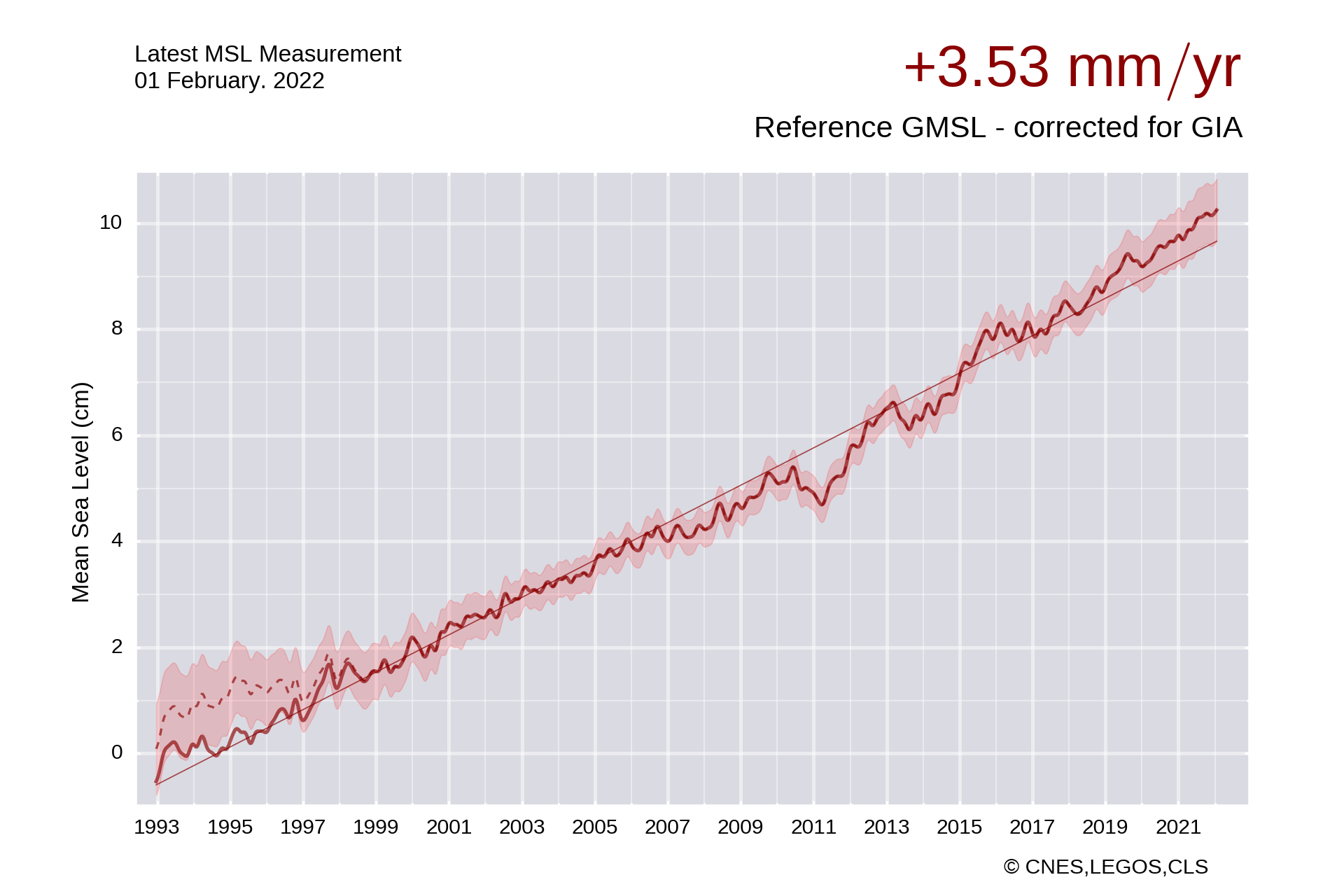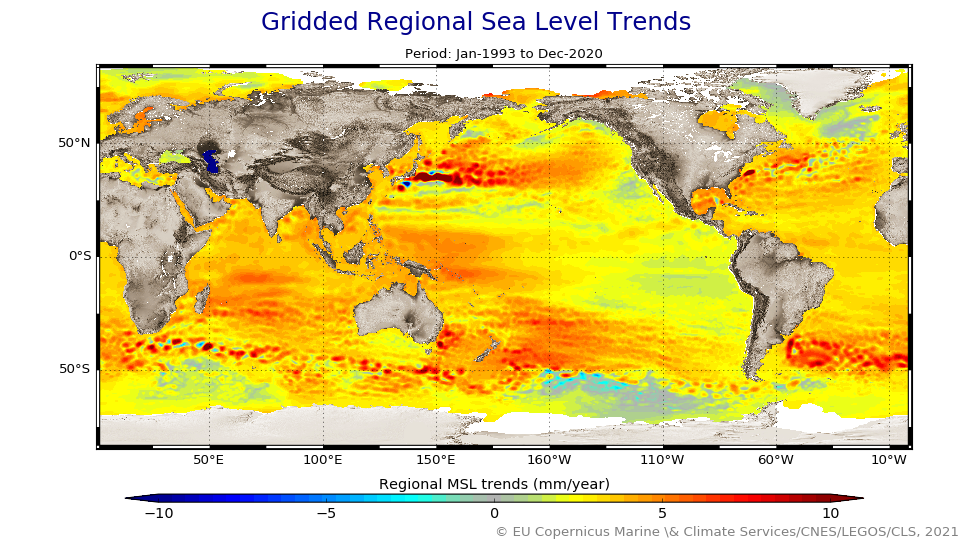Sea level is a very sensitive index of climate change and variability. As the ocean warms in response to global warming, sea waters expands and as a result, sea levels rise. When mountain glaciers melt in response to increasing air temperature, sea levels rise because more freshwater glacial runoff discharges into the oceans.
Similarly, ice mass loss from the ice sheets causes a rise in sea level. The increase of freshwater flowing into the oceans reduces its salinity, decreasing its density and affecting ocean circulation patterns that in turn affect the sea level and its spatial variability.
The global mean level of the oceans is an indicator of climate change. It incorporates the reactions from several different components of the climate system. Precise monitoring of changes in the mean level of the oceans is vitally important for understanding not just the climate but also the socioeconomic consequences of any rise in sea level.
Mean sea level is an average over all the oceans of sea surface height, with respect to a reference. However, what are really sought are the variations of this mean sea level along time. For almost 30 years now, the global mean sea level has been routinely measured over the whole oceanic domain with high-precision satellite altimetry, and such observations show clear evidence of global mean sea level rise (+3.4 +/-0.4 mm/yr).
This mean sea level can be global, but basins (e.g. Atlantic) or regional areas can be computed. The rise in the sea level of the oceans is far from uniform. In fact, while in certain ocean regions the sea level has risen (by up to 20 millimetres a year in places), in others it has remained unchanged or has even fallen. These regional differences, observed by altimetry satellites, mostly reflect sea level fluctuations over several years.
Consequences
A large proportion of the world’s population lives in coastal areas vulnerable to rising sea level. Permanent submersion, repeated flooding, faster erosion of cliffs and beaches and increasingly saline estuaries and salt contamination of groundwater are just some of the possible consequences of a big rise in the sea level near low-lying regions.
The main objective of the sea level CCI project is to produce and validate a Sea Level Essential Climate Variable (ECV) product.
To achieve this global objective, the specific objectives for the Sea Level ECV are:
- To involve the Climate research community and to improve the understanding of this community's needs and thus ensure a perfect consistency between the need and the future development and improvement of the altimeter processing system. A clear gap exists between the requirements expressed by the CGOS and the current status of the altimeter sea level error budget. Consequently, the user consultation carried out during the project is an important step to revisit and to precise these requirements in order to find a consensus between the Climate Research and the Earth Observation communities. The User Requirement Document presents a synthesis of this work.
- To develop, test and select the best algorithms and standards in order to produce high quality sea level products for climate applications. These activities have allowed the altimeter community to work on the development of climate optimised processing algorithms. A large spectrum of algorithms and methods have been assessed during the project and the more relevant for climate applications have been selected. The Round Robin Reports produced within these activities are all available for the users.
- Assess and collect information on the quality and error characteristics of the Sea Level ECV product through the involvement of independent climate research groups. The main objective here is to obtain relevant feedback from the user community in order to qualify the accuracy and suitability of the ECV products and to define new suggestions for improvement. It is also the opportunity to implement an in-depth dialogue between the climate research and Earth Observations communities which is fundamental to address climate change issues.
- Provide a complete specification of the operational production system.
Focus on the current SL_cci achievements
The current phase of the project focuses on the estimate of the sea level close to the coast in order to assess whether the sea level trends at the coast are similar to what can be observed further offshore in the open ocean.
Reprocessed altimeter 10-day Sea Level Anomalies have been computed in all the coastal regions illustrated below.
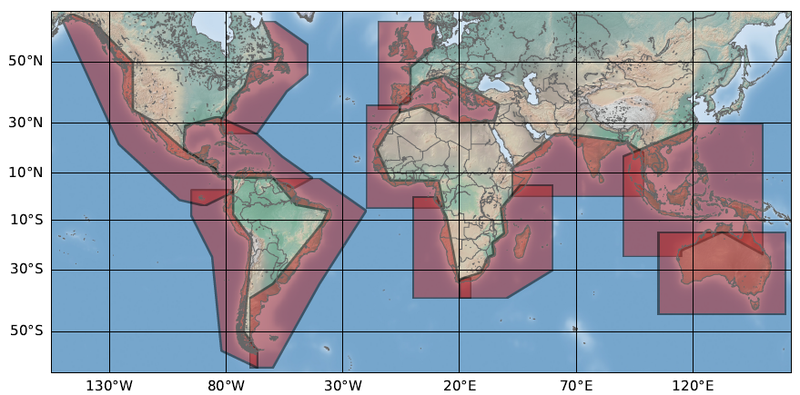
Then, further validation and editing have led to the production of the v2.1 dataset of monthly sea level anomalies and associated trends at 756 selected coastal sites located in almost all the world coastal ocean (see below) covering 2002-2020.
SEE THE ANIMATION OF COASTAL SEA LEVEL VIRTUAL STATIONS
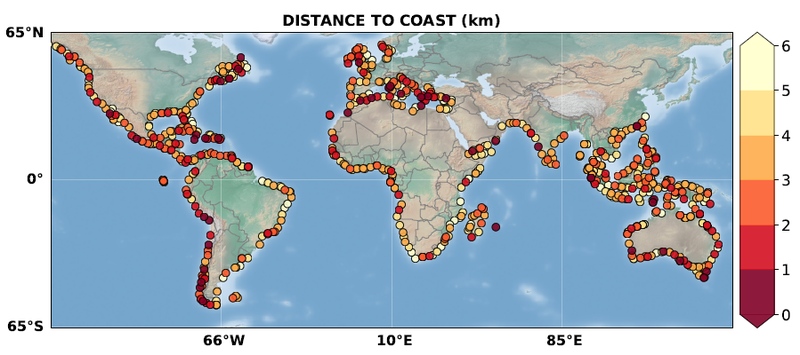
The mean sea level trends observed at the 251 virtual stations located at less than 3.5 km from the coast are shown below during 2002-2020, superimposed with the C3S sea level trends during the same time span.
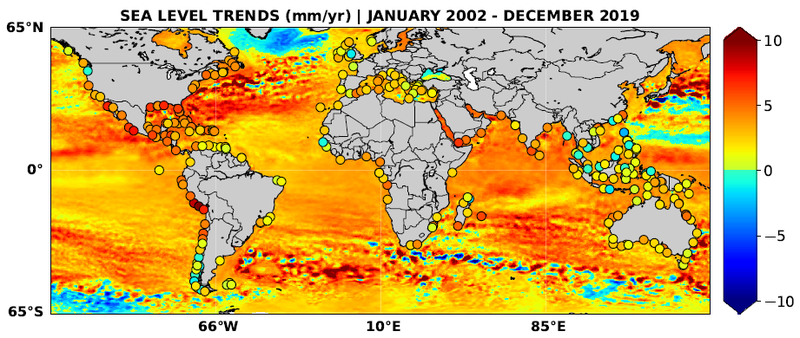
In more than 80% of cases, the sea level trend at the coast is similar to the open ocean trend (considered here at a distance of 15 km from the coast). In the other 20%, we note smaller trend than offshore for ¾ of the sites. This is particularly seen in the southeast Asia region. The remaining sites show slightly larger trends in the last few km to the coast compared to the open ocean. Illustration of the different trend behaviours is presented below as well as a map synthsizing the results.
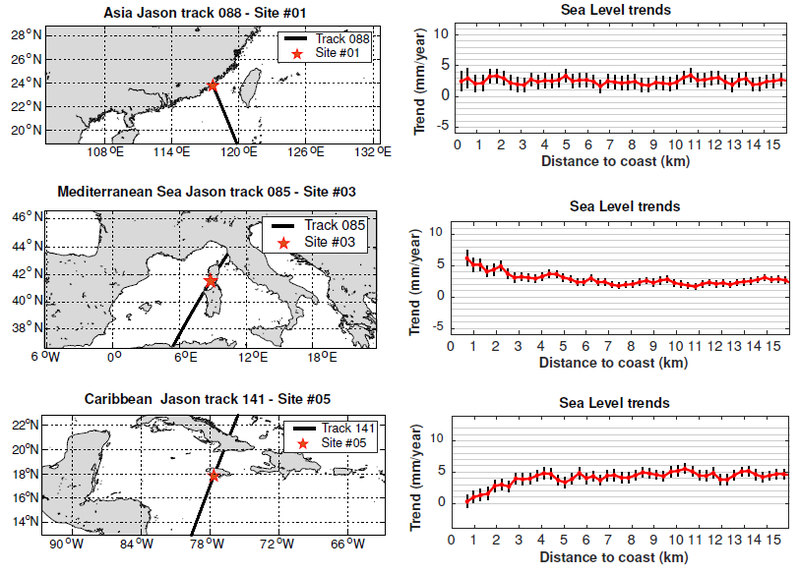
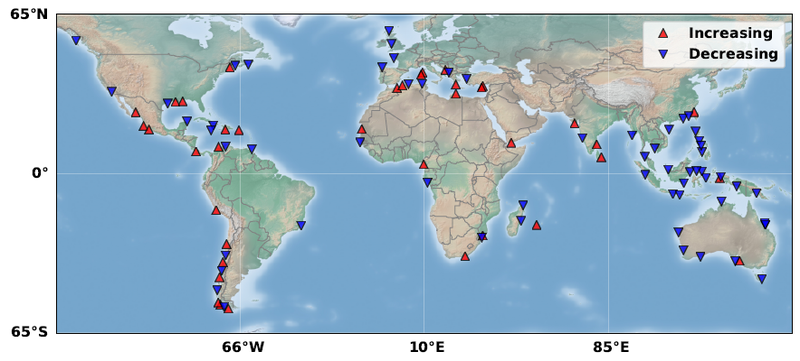
The network of virtual coastal stations proposed here should be of invaluable interest for estimating present-day (absolute) sea level rise along the world coastlines, especially in regions devoid from in situ tide gauges. This is illustrated below with the distribution of the 271 virtual stations located within 3.5 km from the coast and of current tide gauges that have monthly sea level data over the study time span (with not more than 24 months of missing data).
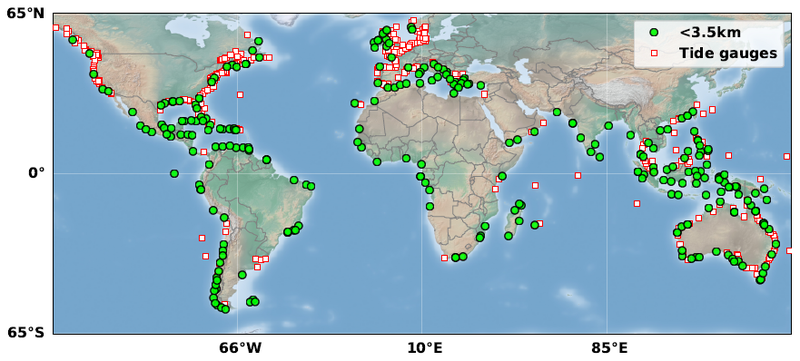
The latest global products including uncertainties are provided via the CCI Open Data Portal
How is Sea Level measured
Past variations can be reconstructed from several indicators, but the very first measurements of sea level were made by monitoring tides in the 18th century. Although we now have a relatively dense network of tide gauges, only 20 stations (mostly along the coasts of Europe and North America) collected data throughout the 20th century. On the basis of their measurements, sea level is estimated to have risen by 10 to 20 centimetres since 1900.
Today, satellite altimetry, autonomous floats (Argo floats since 2005) and gravimetric data (GRACE satellite) enable the measurement of mean sea level variations, or some of their components. Ocean models are also used to understand and quantify those phenomena.
With the satellite altimetry missions, the global mean sea level (GMSL) has been calculated on a continual basis since January 1993. 'Verification' phases, during which the satellites follow each other in close succession (Topex/Poseidon-Jason-1, Jason-1-Jason-2, Jason-2-Jason-3, and then Jason-3-Sentinel-6), help to link up these different missions by precisely determining any bias between them. Envisat, ERS-1 and ERS-2 are also used, after being adjusted on these reference missions, in order to compute Mean Sea Level at high latitudes (higher than 66°N and S), and also to improve spatial resolution by combining all these missions together. In addition, permanent monitoring of quality during the missions and studies of the necessary corrections of altimetry data regularly add to our understanding and knowledge.
Explore the ESA CCI sea level anomalies data (version 2.0) - interactive globe
Why Sea Level varies
There are several possible components which may take their part in the mean rise in sea level: an increase in the temperature of the water, which dilates as it warms, the thawing of mountain glaciers and polar ice caps in Greeland and Antarctica, as well as melting permafrost. Changes to the amount of rainfall and evaporation also play a part, as well as runoff and inland water reserves, mainly owing to human activity such as dam construction and irrigation.
Products
Different altimeter sea level products have been produced and distributed within the Sea Level Climate Change Initiative (SL_CCI) project. Access to the ECV Products and further details are provided via the CCI Open Data Portal. All available SL_cci datasets are presented below and the collection can be found on this page. The users are invited to contact the team for any question on the products: info-sealevel@esa-sealevel-CCI.org.
The different products available are listed below:
The regional network of altimetry-based sea level anomalies and trends at coastal virtual stations, dedicated to the analysis of coastal sea level trends:
- The latest product is the reprocessed improved v2.2 network of altimetry-based sea level virtual stations, DOI: https://doi.org/10.17882/74354, also available in the CCI Open Data Portal. It includes monthly-averaged post-processed sea level anomalies and associated trends estimated along the tracks at 756 selected coastal sites from 2002 to 2019.
SEE THE ANIMATION OF COASTAL SEA LEVEL VIRTUAL STATIONS
See the "little picture" of the sea level along europe's coastline.
Previous versions of the product are no longer recommended for use :
- The V2.1 network of altimetry-based sea level virtual stations (756 coastal sites) included a temporal extension of the previous v1.1 product until Dec. 2019 and a spatial extension around the american continent.
- The V1.1 network of altimetry-based sea level virtual stations in some coastal zones: DOI: https://doi.org/10.17882/74354.
- V1.1 along-track raw sea level anomalies used to compute the sea level trend at coastal virtual stations: v1.1 was the extension of v1.0 in time (up to 2018) and cover three additional regions: North Indian Ocean, South-East Asia and Australia. DOI: 10.5270/esa-sl_cci-xtrack_ales_sla-200206_201805-v1.1-202005.
- V1.0 along-track raw sea level anomalies from 2002 to 2016 in the Western Africa, Mediterranean Sea and North East Atlantic Ocean. DOI: 10.5270/esa-sl_cci-xtrack_ales_sla-200201_201610-v1.0-201910.
The global sea level ECV product is a multi-satellite merged product that consists in a database of different elements that can be referenced with the following DOI: 10.5270/esa-sea_level_cci-1993_2015-v_2.0-201612. The v2.0 dataset covers the period Jan. 1993 to Dec. 2015 and includes:
- Time series of gridded Sea Level Anomalies (SLA):
DOI: 10.5270/esa-sea_level_cci-MSLA-1993_2015-v_2.0-201612
The SLA grids are calculated after merging all the altimetry mission measurements together into monthly grids with a spatial resolution of 1/4 of degree. - Oceanic indicators:
Static files over the whole altimetry operating period describing the evolution of the SLA grids just previously mentioned- Global Mean Sea Level temporal evolution. DOI: 10.5270/esa-sea_level_cci-IND_MSL_MERGED-1993_2015-v_2.0-201612. See the "little picture" of the global mean sea level evolution.
- Regional Mean Sea Level trends. DOI: 10.5270/esa-sea_level_cci-IND_MSLTR_MERGED-1993_2015-v_2.0-201612
- Maps of the amplitude and phase of the annual cycle. DOI: 10.5270/esa-sea_level_cci-IND_MSLAMPH_MERGED-1993_2015-v_2.0-201612
- Fundamental Climate Data Record (FCDR):
The FCDRs are the along-track SLA derived from each altimeter mission, available at 1Hz resolution corresponding to a ground distance of about 7 km. The files include a quality control and all altimeter standards applied in the SLA calculation. Global and regional inter missions biases are also included. - Errors of oceanic indicators:
The Climate Assessment Report presents the work dedicated to the quality assessment of the products by the Climate Research Group and the Comprehensive Error Characterization Report describes the altimetry error budget (different sources of altimetry errors, global MSL confidence envelop, etc).
- WARNING 1: An instrumental drift has been detected in the TOPEX-A altimeter measurements during 1993-1998 and the users are informed that the SL_cci v2.0 global sea level maps (and the corresponding FCDRs as well as the derived indicators) have not been corrected for this drift. Depending on the application, the users are invited to correct the time series for this drift (see WCRP Global Sea Level Budget Group, 2018).
- WARNING 2: Following the ESA CCI efforts made to produce the sea level record, the operational production of the climate-oriented sea level product has now been taken over by the Copernicus Climate Change Service (C3S, https://climate.copernicus.eu/ ) through the climate data store (dataset "Sea level daily gridded data..."). Data after 2015 are available and in order to be consistent, you are invited to download the total C3S timeseries from 1993 onwards.
A CLS/PML improved sea level Arctic product (maps of sea level anomalies) based on the Envisat and SARAL/AltiKa missions. Data access in the CCI Open Data Portal.
A DTU/TUM gridded sea level product at high latitudes (Arctic and Antarctic) has been produced based on ERS-1 & 2, Envisat and CryoSat-2 missions. Data access in the CCI Open Data Portal.
The altimeter SL_cci sea level anomalies (v2.0 global ECV product) have been produced with the use of the Dynamic Atmospheric Correction (DAC) forced by the ERA-Interim reanalysis. The associated 6-hourly global grids are available for the users. Contact info-sealevel@esa-sealevel-CCI.org for access to this dataset. (not available in the Open Data Portal, ODP)
Documentation
The Product User Guides (PUG) related to the global sea level ECV product and the XTRACK/ALES regional coastal product can be found in the “Key Documents” section. The description of the different products and their validation can be found in the technical documents listed in this section, in the references listed below and in peer-reviewed articles of the SL_cci team listed here.
Terms and conditions & Acknowledgement
The Sea Level CCI datasets may be used by any user for any purpose ("CC-BY" licence).
Users of the Sea Level CCI datasets are invited to cite the relevant DOI (as mentioned in the above table) and cite the relevant articles (see table below)
- The Sea Level ECV v2.0
Legeais, J.-F., Ablain, M., Zawadzki, L., Zuo, H., Johannessen, J. A., Scharffenberg, M. G., Fenoglio-Marc, L., Fernandes, M. J., Andersen, O. B., Rudenko, S., Cipollini, P., Quartly, G. D., Passaro, M., Cazenave, A., and Benveniste, J.: An improved and homogeneous altimeter sea level record from the ESA Climate Change Initiative, Earth Syst. Sci. Data, 10, 281-301, https://doi.org/10.5194/essd-10-281-2018, 2018.
Quartly, G. D., Legeais, J.-F., Ablain, M., Zawadzki, L., Fernandes, M. J., Rudenko, S., Carrère, L., García, P. N., Cipollini, P., Andersen, O. B., Poisson, J.-C., Mbajon Njiche, S., Cazenave, A., and Benveniste, J.: A new phase in the production of quality-controlled sea level data, Earth Syst. Sci. Data, 9, 557-572, https://doi.org/10.5194/essd-9-557-2017, 2017.
- The regional XTRACK-ALES coastal sea level product
Birol F., F. Léger, M. Passaro, A. Cazenave, F. Niño, F. Callafat, A. Shaw, J.-F. Legeais, Y. Gouzenes, C. Schwatke and J. Benveniste. The X-TRACK/ALES multi-mission processing system: new advances in altimetry towards the coast, Advances in Space Research, https://doi.org/10.1016/j.asr.2021.01.049, 2021.
Passaro, M., A., N., Zulfikar, 2018. Improving the precision of sea level data from satellite altimetry with high-frequency and regional sea state bias corrections, Remote Sensing of Environment, 218, 245-254, https://doi.org/10.1016/j.rse.2018.09.007.
- The network of altimetry-based virtual stations (monthly SLA and trends at selected sites):
Cazenave A., Gouzenes Y., Birol F., Leger F., Passaro M., M. Calafat F., Shaw A., Nino F., Legeais J.-F., Oelsmann J., Restano M. and Benveniste J., Sea level along the world’s coastlines can be measured by a network of virtual altimetry stations. Commun Earth Environ 3, 117 (2022). https://doi.org/10.1038/s43247-022-00448-z
Benveniste and the Climate Change Initiative Coastal Sea Level Team., Coastal sea level anomalies and associated trends from Jason satellite altimetry over 2002–2018. Sci Data 7, 357 (2020). https://doi.org/10.1038/s41597-020-00694-w
Other documents
The following organisations make up the Sea Level project team.
The ESA Coastal Sea Level CCI activities (2019 - on going):
The project team involved in the Sea Level CCI activities includes 4 companies/institutes from 3 ESA member states. The consortium has been built to integrate partners from the Earth Observation, Oceanography and Climate communities, all providing internationally acknowledged expertise:
- CLS, France,
- CNRS/LEGOS, France,
- National Oceanography Center (NOC), United Kingdom,
- Technical University of Munich (TUM), Germany.
The Expertise:
- The organisation for the Sea Level CCI+ includes the science leadership assigned to Dr Anny Cazenave (LEGOS) who is internationally recognised for her scientific expertise in the field of altimetry and climate.
- CLS will ensure the project leadership through the project manager (Dr Jean-François Legeais). CLS is also involved in the characterisation of regional mean sea level uncertainties (Dr Pierre Prandi).
- LEGOS is also in charge of the system development and processing of the altimeter products (Dr Florence Birol) as well as the product quality assessment (Dr Anny Cazenave) and the uncertainty characterisation (Dr Benoît Meyssignac). Dr Anny Cazenave is the Science Leader for SL_CCI+.
- TUM (Dr Marcello Passaro) is in charge of the provision of the ALES ranges to be used in the sea level products.
- NOC (Dr Francisco Calafat) is in charge of the validation of the altimeter sea level products with the support of SkyMAT Ltd (Dr Andrew Shaw).
The first ohases of the SL_CCI project (2011-2019):
The project team involved in phase II of the SL_CCI project has included 15 companies/institutes from over 7 countries and has been built to integrate expertise in the fields of Earth Observation and Climate Modelling. The team members are CLS, LEGOS, CGI, IsardSAT, DTU, GFZ, NOC, University of Porto, PML, University of Hamburg, NERSC, ECMWF, TUD, University of Bonn and TUM.
The Expertise:
The Science leadership has been assigned to Anny Cazenave who has an internationally recognized scientific expertise in the field of altimetry and climate.
While CLS will ensure the SLCCI-Phase 2 project leadership through the project manager (G. Larnicol / JF Legeais), the full strength of the consortium comes from the 3 core groups involved in the project: Earth Observations team, Climate research group and system engineering team respectively led by M. Ablain (CLS), D. Stammer (UoH) and C. Farquhar (CGI).
The Consortium
The consortium has been built to integrate core partners from the Earth Observations community (CLS, GFZ, isardSAT, DTU Space, LEGOS) and from the Climate modelling community (UoH, ECMWF, NERSC), all having an internationally acknowledged expertise in their field of expertise.
A list of publications produced by the Sea Level CCI project team is maintained here.
2025-peer-reviewed | 2024-peer-reviewed | 2023 – Peer Reviewed | 2022 – Peer Reviewed | 2021 – Peer Reviewed | 2020 – Peer Reviewed | 2019 – Peer Reviewed | 2019 – Technical Reports | 2018 – Peer Reviewed | 2018 – Technical Reports | 2017 – Peer Reviewed | 2017 – Technical Reports | 2016 – Peer Reviewed | 2016 – Conference Proceedings and Communications | 2016 – Technical Reports | 2015 – Peer Reviewed | 2015 – Conference Proceedings and Communications | 2014 – Peer Reviewed | 2014 – Conference Proceedings and Communications | 2014 – Technical Reports | 2013 – Peer Reviewed | 2013 – Conference Proceedings and Communications | 2012 – Peer Reviewed | 2012 – Conference Proceedings and Communications | 2012 – Technical Reports | 2011 – Peer Reviewed | 2011 – Conference Proceedings and Communications | 2011 – Technical Reports
Item Classification:
- (1) Dealing with the SL-CCI dataset
- (2) Climate-related subject
- (3) Others
2025 - Peer Reviewed
(2) Cazenave, A., Pfeffer, J., Mandea, M. et al. Why is the Earth System Oscillating at a 6-Year Period?. Surv Geophys (2025). https://doi.org/10.1007/s10712-024-09874-4
(1) Leclercq L., Cazenave A., Leger F., Birol F., Nino F., Tolu L and Legeais JF. Coastal sea level rise at altimetry-based virtual stations in the Gulf of Mexico. Advances in Space Research, 75, 1636-1652, https://doi.org/10.1016/j.asr.2024.11.069, 2025a.
(1) Leclerq L., Dieng H.B., Cazenave A., Birol F., Oelsmann J., Passaro M., Jevrejeva S., Bergsma E. and Connors S., Spatio-temporal changes in interannual sea level along the world coastlines, submitted to Global and Planetary Change, 2025b.
2024 - Peer Reviewed
(2) Birol F., F. Bignalet-Cazalet, M. Cancet, J.-A. Daguze, W. Fkaier, E. Fouchet, F. Léger, C. Maraldi, F. Niño, M.-I. Pujol, N. Tran, Understanding uncertainties in coastal sea level altimetry data: insights from a round robin analysis. Ocean Science preprint https://egusphere.copernicus.org/preprints/2024/egusphere-2024-2449/egusphere-2024-2449.pdf, https://doi.org/10.5194/egusphere-2024-2449.
(1) Li, G., Törnqvist, T.E. & Dangendorf, S. Real-world time-travel experiment shows ecosystem collapse due to anthropogenic climate change. Nat Commun 15, 1226 (2024). https://doi.org/10.1038/s41467-024-45487-6
(1) Shaw, Andrew G.P. and Jevrejeva, Svetlana and Calafat, Francisco Mir, An Improvement to Short Term Variability in Global Mean Sea Level Reconstruction. Available at SSRN: https://ssrn.com/abstract=4924577
(2) Thirion, G., F. Birol, and J. Jouanno (2024). Loop Current eddies as a possible cause of the rapid sea level rise in the Gulf of Mexico. Journal of Geophysical Research: Oceans, 129, e2023JC019764. https://doi. org/10.1029/2023JC019764
2023 – Peer Reviewed
(2) Barnoud, A., Picard, B., Meyssignac, B., Marti, F., Ablain, M., & Roca, R. (2023). Reducing the uncertainty in the satellite altimetry estimates of global mean sea level trends using highly stable water vapour climate data records. Journal of Geophysical Research: Oceans, 128, e2022JC019378. https://doi.org/10.1029/2022JC019378
(1) Djeumeni, L., F. Birol, R. Onguene, F. Léger, F. Nino, R. Dzonde Naoussi, Virtual coastal altimetry tide gauges along the West African coast. Estuarine, Coastal and Shelf Science, 2023, 108600, ISSN 0272-7714, https://doi.org/10.1016/j.ecss.2023.108600.
2022 – Peer Reviewed
(1) Anny Cazenave, Yvan Gouzenes, Florence Birol, Fabien Leger, Marcello Passaro, Francisco M. Calafat, Andrew Shaw, Fernando Nino, Jean François Legeais, Julius Oelsmann, Marco Restano & Jérôme Benveniste, Sea level along the world’s coastlines can be measured by a network of virtual altimetry stations. Commun Earth Environ 3, 117 (2022). https://doi.org/10.1038/s43247-022-00448-z
(2) Guérou, A., Meyssignac, B., Prandi, P., Ablain, M., Ribes, A., and Bignalet-Cazalet, F.: Current observed global mean sea level rise and acceleration estimated from satellite altimetry and the associated uncertainty, EGUsphere [preprint], https://doi.org/10.5194/egusphere-2022-330, 2022.
(2) Oelsmann, J., Passaro, M., Sánchez, L., Dettmering D., Schwatke and Seitz F., Bayesian modelling of piecewise trends and discontinuities to improve the estimation of coastal vertical land motion. J Geod 96, 62 (2022). https://doi.org/10.1007/s00190-022-01645-6
2021 – Peer Reviewed
(1) Birol F., F. Léger, M. Passaro, A. Cazenave, F. Niño, F. Callafat, A. Shaw, J.-F. Legeais, Y. Gouzenes, C. Schwatke and J. Benveniste. The X-TRACK/ALES multi-mission processing system: new advances in altimetry towards the coast, Advances in Space Research, 10.1016/j.asr.2021.01.049, 2021.
(1) Cavaleri, L., Bertotti, L., Ferrarin, C., Passaro, M., Pezzutto, P., Pomaro, A.: Synergic use of altimeter and model sea level data in inner and coastal seas, Remote Sensing of Environment, 261, 2021, https://doi.org/10.1016/j.rse.2021.112500.
(2) Dettmering, D., Müller, F. L., Oelsmann, J., Passaro, M., Schwatke, C., Restano, M., Benveniste, J., and Seitz, F.: North SEAL: a new dataset of sea level changes in the North Sea from satellite altimetry, Earth Syst. Sci. Data, 13, 3733–3753, https://doi.org/10.5194/essd-13-3733-2021, 2021.
(1) Dieng, H.B., A. Cazenave, Y. Gouzenes, B.A. Sow, Trends and inter-annual variability of altimetry-based coastal sea level in the Mediterranean Sea: Comparison with tide gauges and models, Advances in Space Research, 2021, https://doi.org/10.1016/j.asr.2021.06.022.
(3) Hart-Davis, M. G., Piccioni, G., Dettmering, D., Schwatke, C., Passaro, M., and Seitz, F.: EOT20: a global ocean tide model from multi-mission satellite altimetry, Earth Syst. Sci. Data, 13, 3869–3884, https://doi.org/10.5194/essd-13-3869-2021, 2021.
(1) Nicholls, R.J., Lincke, D., Hinkel, J. Brown, S., Vafeidis, A. T., Meyssignac, B., Hanson, S. E., Merkens, J-L., Fang, J., A global analysis of subsidence, relative sea-level change and coastal flood exposure. Nat. Clim. Chang. (2021). https://doi.org/10.1038/s41558-021-00993-z
(2) Passaro M, Müller FL, Oelsmann J, Rautiainen L, Dettmering D, Hart-Davis MG, Abulaitijiang A, Andersen OB, Høyer JL, Madsen KS, Ringgaard IM, Särkkä J, Scarrott R, Schwatke C, Seitz F, Tuomi L, Restano M and Benveniste J (2021) Absolute Baltic Sea Level Trends in the Satellite Altimetry Era: A Revisit. Front. Mar. Sci. 8:647607, https://doi.org/10.3389/fmars.2021.647607
(2) Passaro M., Hemer M., Quartly G.D., Schwatke C., Dettmering D., Seitz F.: Global coastal attenuation of wind-waves observed with radar altimetry, Nature Communications (2021), https://doi.org/10.1038/s41467-021-23982-4
(1) Prandi, P., Meyssignac, B., Ablain, M. Spada, G., Ribes, A. & Benveniste, J., Local sea level trends, accelerations and uncertainties over 1993-2019. Sci Data 8, 1 (2021). https://doi.org/10.1038/s41597-020-00786-7
2020 – Peer Reviewed
(1) The Climate Change Initiative Coastal Sea Level Team., Coastal sea level anomalies and associated trends from Jason satellite altimetry over 2002–2018. Sci Data 7, 357 (2020). https://doi.org/10.1038/s41597-020-00694-w
(1) Gouzenes, Y., Léger, F., Cazenave, A., Birol, F., Bonnefond, P., Passaro, M., Nino, F., Almar, R., Laurain, O., Schwatke, C., Legeais, J.-F., and Benveniste, J.: Coastal sea level rise at Senetosa (Corsica) during the Jason altimetry missions, Ocean Sci., 16, 1165–1182, https://doi.org/10.5194/os-16-1165-2020, 2020.
2019 – Peer Reviewed
(1) Ablain, M., Meyssignac, B., Zawadzki, L., Jugier, R., Ribes, A., Spada, G., Benveniste, J., Cazenave, A., and Picot, N.: Uncertainty in satellite estimates of global mean sea-level changes, trend and acceleration, Earth Syst. Sci. Data, 11, 1189–1202, https://doi.org/10.5194/essd-11-1189-2019, 2019.
(1) Benveniste J., Cazenave A., Vignudelli S., Fenoglio-Marc L., Shah R., Almar R., Andersen O., Birol F., Bonnefond P., Bouffard J., Calafat F., Cardellach E., Cipollini P., Dufau C., Fernandes J., ., Garrison J., Frappart F., Gommenginger C., Han G., Høyer J. L., Kourafalou V., Le Cozannet G., Leuliette E., Li Z., Loisel H., Madsen K. S., Marcos M., Melet A., Meyssignac B., Passaro M., Pasqual A., Passaro M., Ribo S., Scharroo R., Song T., Speich S., Wilkin J, Woodworth P., Wöppelmann G., Requirements for a Coastal Hazard Observing System, OceanObs’19 Community White Paper, Frontiers in Marine Science, 6, 348, 2019, DOI: 10.3389/fmars.2019.00348.
(2) Cazenave A., Hamlington B., Horwath M., Barletta V., Benveniste J., Chambers D., Döll P., Hogg A., Legeais J.F., Merrifield M., Meyssignac B., Mitchum G., Nerem S., Pail R., Palanisamy H., Paul F., von Schuckmann K., P. Thompson P., Observational requirements for long-term monitoring of the global mean sea level and its components, Frontiers in Marine Science, 6,:582. doi: 10.3389/fmars.2019.00582, 2019.
(1) Léger F., Birol F., Niño F., Passaro M., Marti F., Cazenave A., X-Track/Ales Regional Altimeter Product for Coastal Application: Toward a New Multi-Mission Altimetry Product at High Resolution, IGARSS 2019 - 2019 IEEE International Geoscience and Remote Sensing Symposium, DOI: 10.1109/IGARSS.2019.8900422.
(1) Marti F., Cazenave A., Birol F., Passaro, M. Leger F., Nino F., Almar R., Benveniste J. and Legeais J.F., Altimetry-based sea level trends along the coasts of western Africa, Advances in Space Research, published online 24 May2019, https://doi.org/10.1016/j.asr.2019.05.033, 2019.
(2) Meyssignac, B., Boyer, T., Zhao, Z., Hakuba, M. Z., Landerer, F. W., Stammer, D., Köhl, A. Kato, S., L’Ecuyer, T., Ablain, M., Abraham, J.P., Blazquez, A., Cazenave, A., Church, J.A., Cowley, R. Cheng, L., Domingues, C.M., Giglio, D., Gouretski, V., Ishii, M., Johnson, G.C., Killick, R.E., Legler, D., Llovel, W., Lyman, J., Palmer, M.D., Piotrowicz, S., Purkey, S.G., Roemmich, D., Roca, R., Savita, A., Schuckmann, K. von, Speich, S. Stephens, G., Wang, G., Wijffels, S.E., Zilberman, N., Measuring Global Ocean Heat Content to estimate the Earth Energy Imbalance. Frontiers in Marine Science, 6, 432, 2019, DOI: 10.3389/fmars.2019.00432.
(2) Ponte R., Carson M., Cirano M., Domingues C., Jevrejeva S., Marcos M., Mitchum G., Van de Wal R. S. W., Woodworth P. L., Ablain M., Ardhuin F., Ballu V., Becker M., Benveniste J., Birol F., Bradshaw E., Cazenave A., Demey-Fremaux P., Durand F., Ezer T., Fu L. L., Fukumori I., Gordon K., Gravelle M., Griffies S. M., Han W., Hibbert A., Hughes C. W., Idier D., Kourafalou V. H., Little C. M., Matthews A., Melet A., Merrifield M., Meyssignac B., Minobe S., Penduff T., Picot N., Piecuch C., Ray R. D., Richards L., Santamaria- Gómez A., Stammer D., Staneva J., Testut L., Thompson K., Thompson P.,Vignudelli S., Williams J., Williams S. D. P., Wöppelmann G., Zanna L., Zhang X.: Towards comprehensive observing and modeling systems for monitoring and predicting regional to coastal sea level, OceanObs’19 Community White Paper, Frontiers in Marine Science, 6, 437,2019, DOI: 10.3389/fmars.2019.00437.
(2) Quartly, G.D.; Rinne, E.; Passaro, M.; Andersen, O.B.; Dinardo, S.; Fleury, S.; Guillot, A.; Hendricks, S.; Kurekin, A.A.; Müller, F.L.; Ricker, R.; Skourup, H.; Tsamados, M. Retrieving Sea Level and Freeboard in the Arctic: A Review of Current Radar Altimetry Methodologies and Future Perspectives. Remote Sens. 2019, 11, 881.
(2) Rudenko, S., Esselborn, S., Schöne, T., and Dettmering, D.: Impact of terrestrial reference frame realizations on altimetry satellite orbit quality and global and regional sea level trends: a switch from ITRF2008 to ITRF2014, Solid Earth, 10, 293-305, https://doi.org/10.5194/se-10-293-2019, 2019.
(2) Smith, G. C., Allard, R., Babin, M., Bertino, L., Chevallier, M., Corlett, G., Crout, J., Davidson, F., Delille, B., Gille, S.T., Hebert, D., Hyder, P., Intrieri, J., Lagunas, J., Larnicol, G., Kaminski, T., Kater, B., Kauker, F., Marec, C., Mazloff, M., Metzger, E. J., Mordy, C., O’Carroll, A., Olsen, S.M., Phelps, M., Posey, P., Prandi, P., Rehm, E., Reid, P., Rigor, I., Sandven, S., Shupe, M., Swart, S., Smedstad, O.M., Solomon, A., Storto, A., Thibaut, P., Toole, J., Wood, K., Xie, J., Yang, Q. and the WWRP PPP Steering Group,: Polar Ocean Observations: A Critical Gap in the Observing System and Its Effect on Environmental Predictions From Hours to a Season, Frontiers in Marine Science, 6, 429, 2019,DOI=10.3389/fmars.2019.00429.
2019 – Technical Reports
SL_cci, D1: Altimeter Mean Sea Level uncertainties (P. Prandi and B. Meyssignac).http://www.esa-sealevel-cci.org/webfm_send/586
SL_cci, D2, Part I: Altimetry-based sea level trends in some coastal regions (F. Marti, A. Cazenave, F. Leger, F. Nino, M. Passsaro). http://www.esa-sealevel-cci.org/webfm_send/591
SL_cci, D3, Part II: Validation of the SL_cci BP coastal sea level products (F. Calafat, A Shaw, F. De Biaso, S. Vignudelli). http://www.esa-sealevel-cci.org/webfm_send/588
2018 – Peer Reviewed
(2) Esselborn, S., Rudenko, S., and Schöne, T.: Orbit-related sea level errors for TOPEX altimetry at seasonal to decadal timescales, Ocean Sci., 14, 205-223, https://doi.org/10.5194/os-14-205-2018, 2018.
(2) Gruber, C., Rudenko, S., Groh, A., Ampatzidis, D., and Fagiolini, E.: Earth's surface mass transport derived from GRACE, evaluated by GPS, ICESat, hydrological modeling and altimetry satellite orbits, Earth Surface Dynamics, 6, 1203-1218, https://doi.org/10.5194/esurf-6-1203-2018, 2018.
(1) Legeais, J.-F., Ablain, M., Zawadzki, L., Zuo, H., Johannessen, J. A., Scharffenberg, M. G., Fenoglio-Marc, L., Fernandes, M. J., Andersen, O. B., Rudenko, S., Cipollini, P., Quartly, G. D., Passaro, M., Cazenave, A., and Benveniste, J.: An improved and homogeneous altimeter sea level record from the ESA Climate Change Initiative, Earth Syst. Sci. Data, 10, 281-301, https://doi.org/10.5194/essd-10-281-2018, 2018.
2018 – Technical Reports
(2) Rudenko, S., Schöne, T., Esselborn, S., Neumayer, K. H.: GFZ VER13 SLCCI precise orbits of altimetry satellites ERS-1, ERS-2, Envisat, TOPEX/Poseidon, Jason-1, and Jason-2 in the ITRF2014 reference frame. GFZ Data Services. http://doi.org/10.5880/GFZ.1.2.2018.003, 2018.
2017 – Peer Reviewed
(3) Chambers, D., O. Andersen, S. Bettadpur, M.-H. Rio, R. Rummel, D. Wiese (2017) Auxiliary Space-Based Systems for Interpreting Satellite Altimetry: Satellite Gravity, In CRC Book on satellite altimetry, guest editors Stammer, D. and Cazenave, A.(2) Cipollini, P., F. Birol, M. J. Fernandes, E. Obligis, M. Passaro, P. T. Strub, G. Valladeau, S. Vignudelli, J. Wilkin (2017) Satellite altimetry in coastal regions, In CRC Book on satellite altimetry, guest editors Stammer, D. and Cazenave, A.
(3) Buchhaupt, C., Fenoglio-Marc, L., Dinardo, S. (2017) Retracking CryoSat-2 data with pulse limited processing, AdSR special session CryoSat-2, submitted January 2017
(2) Dinardo, S., Buchhaupt, C., Fenoglio-Marc, L., Fernandez J. CryoSat-2 (2017) Performance along the german coasts, AdSR special session CryoSat-2, submitted January 2017
(3) Escudier, P. A. Couhert, F. Mercier, A. Mallet, P. Thibaut, N. Tran, L. Amarouche, B. Picard, L. Carrère, G. Dibarboure, M. Ablain, J. Richard, N. Steunou, P. Dubois, M. H. Rio, J. Dorandeu (2017) Satellite radar altimetry: principle, geophysical correction and orbit, accuracy and precision, In CRC Book on satellite altimetry, guest editors Stammer, D. and Cazenave, A.
(2) Johannessen, J.A. and Andersen, O. B. (2017) The high latitude seas and Arctic Ocean, In CRC Book on satellite altimetry, guest editors Stammer, D. and Cazenave, A.
(2) Lee, T., J.Thomas Farrar, Sabine Arnault, Benoit Meyssignac, Weiqing Han, Theodore Durland (2017) Monitoring and interpreting the tropical oceans by satellite altimetry, In CRC Book on satellite altimetry, guest editors Stammer, D. and Cazenave, A(2) Nerem, S., M. Ablain, A. Cazenave, J. Church, E. Leuliette (2017) A 25-year long satellite altimetry-based global mean sea level record; Closure of the sea level budget & missing components, In CRC Book on satellite altimetry, guest editors Stammer, D. and Cazenave, A.
(1) Quartly, G. D., Legeais, J.-F., Ablain, M., Zawadzki, L., Fernandes, M. J., Rudenko, S., Carrère, L., García, P. N., Cipollini, P., Andersen, O. B., Poisson, J.-C., Mbajon Njiche, S., Cazenave, A., and Benveniste, J.: A new phase in the production of quality-controlled sea level data, Earth Syst. Sci. Data, vol. 9, Is. 2, pp. 557-572, https://doi.org/10.5194/essd-9-557-2017, 2017.
(2) Rudenko, S., Neumayer, K.-H., Dettmering, D., Esselborn, S., Schöne, T., Raimondo, J.-C. (2017) Improvements in precise orbits of altimetry satellites and their impact on mean sea level monitoring, IEEE Transactions on Geoscience and Remote Sensing, vol. 55, Is. 6, pp. 3382 - 3395, DOI: 10.1109/TGRS.2017.2670061, https://doi.org/10.1109/TGRS.2017.2670061, June 2017.
(2) Smyth, T.J., Quartly, G.D., Jackson, T., Tarran, G., Woodward M., Harris, C., Gallienne, C., Thomas, R., Airs, R., Cummings, D., Brewin, R., Kitidis, V., Stephens, J., Zubkov, M.V., Rees, A.P. (2017) Determining Atlantic Ocean province contrasts and variations, accepted by Prog. Oceanogr. (22pp.) http://dx.doi.org/10.1016/j.pocean.2016.12.004
(2) Stammer, D., S. Griffies (2017) Ocean Modeling and Data Assimilation in the Context of Satellite Altimetry, In CRC Book on satellite altimetry, guest editors Stammer, D. and Cazenave, A.
2017 – Technical reports
(2) Rudenko S., Neumayer K.-H., Raimondo J.-C., König R.: GFZ Associated Analysis Center, International DORIS Service Activity Report 2016, International DORIS Service, 70-74, https://ids-doris.org/documents/report/IDS_Report_2016.pdf, 2017. (2) Reckeweg, F., Becker, M., Fenoglio-Marc, L., (2017) GNSS Station coordinates and trend of vertical component Zenith Total Delay Sea level, mass and steric components in Mediterranean Sea. Technical Note SLCCI-D5-GPSDataAnalysis-v3.0, submitted.
2016 – Peer Reviewed
(2) Ablain M., Legeais J.F., Prandi P., Fenoglio-Marc L., Marcos M., Benveniste J., Cazenave A. (2016) Altimetry-based sea level, global and regional, Surveys in Geophysics, doi:10.1007/s10712-016-9389-8.
(2) Ashton, I.G., Shutler, J.D, Land, P., Woolf, D.K., Quartly, G.D. (2016) A sensitivity analysis of the impact of rain on regional and global sea-air fluxes of CO2. PLOS One 11(9): e0161105 doi: 10.1371/journal.pone.0161105.
(2) Carret A., Johannessen J., Andersen O., Ablain M., Prandi P., Blazquez A., Cazenave A. (2016) Arctic sea level during the altimetry era, Surveys in Geophysics, doi:10.1007/s10712-016-9390-2.
(1) Cipollini, P., Calafat, F.M., Jevrejeva, S., Melet, A., Prandi, P. (2016) Monitoring sea level in the coastal zone with satellite altimetry and tide gauges, Surveys in Geophysics - Special issue on Sea Level, doi: 10.1007/s10712-016-9392-0.
(2) Dieng, H.B., Cazenave, A., Meyssignac, B., Von Schuckmann, K., Palanisamy, H. (2016) Sea and land surface temperatures, ocean heat content, Earth’s energy imbalance and net radiative forcing over the last decade, ERL-102153.
(2) Fernandes, M.J., Lázaro, C. (2016) GPD+ Wet Tropospheric Corrections for CryoSat-2 and GFO Altimetry Missions, Remote Sensing. 2016, 8(10), 851; doi:10.3390/rs8100851 (http://www.mdpi.com/2072-4292/8/10/851)
(3) Kersalé, M., Petrenko, A.A., Doglioli, A.M., Nencioli, F., Bouffard, J., Blain, S., Diaz, F., Labasque, T., Queguiner, B., Dekeyser, I. (2016) Lateral diffusivity coefficients from the dynamics of a SF6 patch in a coastal environment. Journal of Marine Systems, 153. 42-54. 10.1016/j.jmarsys.2015.09.003.
(2) Legeais, J-F., Prandi, P., Guinehut, S. (2016) Analyses of altimetry errors using Argo and GRACE data, Ocean Sci., 647-662, doi:10.5194/os-12-647-2016.
(2) Marcos, M., Marzeion, B., Dangendorf, S., Slangen, A., Palanisamy, H., Fenoglio-Marc, L. (2016) Internal variability versus anthropogenic forcing on sea level and its components, Special Issue on Sea Level, Integrative Study of the Mean Sea Level and its Components, Surveys in Geophysics, DOI 10.1007/s10712-016-9373-3.
(2) Meyssignac, B., Piecuch, C.G., Merchant, C.J., Racault, M-F., Palanisamy, H., <cIntosh, C., Sathyendranath, S., Brewin, R. (2016) Causes of the regional variability in observed sea level, sea surface temperature and ocean colour, Surveys in Geophysics, Manuscript Number: GEOP-D-16-00027.
(3) Passaro, M., Dinardo, S., Quartly, G.D., Snaith, H., Benveniste, J., Cipollini, P., Lucas, B. (2016) Cross-calibrating ALES Envisat and CryoSat-2 delay-Doppler: A coastal altimetry study in the Indonesian Seas Adv. Space Res. 58, 289-303. doi:10.1016/j.asr.2016.04.011
(1) Raj, R.P, Johannessen, J. A., Eldevik, T., Nilsen, J. E.Ø., Halo, I. (2016), Quantifying mesoscale eddies of the Lofoten Basin, Journal of Geophys. Res. Oceans, 121, doi:10.1002/2016JC011637.
(1) Rudenko, S., Dettmering, D., Esselborn, S. Fagiolini, E., Schöne, T. (2016) Impact of Atmospheric and Oceanic De-Aliasing Level-1B (AOD1B) products on precise orbits of altimetry satellites and altimetry results, Geophysical Journal International, 204, 1695-1702.
(3) Rees, A. P., Widdicombe, C.E. , Tait, K., Quartly, G.D., McEvoy, A., Al-Moosawi, L. (2016) Metabolically active, non-nitrogen fixing, Trichodesmium in UK coastal waters during winter, J. Plankton Res. doi: 10.1093/plankt/fbv123
(3) Shutler, J.D., Quartly, G.D., Donlon, C.J., Sathyendranath, S., Platt, T., Chapron, B., Johannessenen, J.A., Girard-Ardhuin, F., Nightingale, P.D., Woolf, D.K., Hoyer, J.L. (2016). Progress in Earth observation for studying physical oceanography: surface currents, storm surges, sea-ice, atmosphere-ocean gas exchange and surface heat fluxes, Progress in Phys. Geog., 40 (2), 215-246. doi: 10.1177/0309133316638957 (3) Staneva, J., Wahle, K., Koch, W., Behrens, A., Fenoglio-Marc, L., Stanev, E. (2016). Coastal flooding: impact of waves on storm surge during extremes. A case study for the German Bight. Natural Hazards and Earth System Sciences, doi:10.5194/nhess.2016-227
(2) Von Schuckmann, K., Palmer, M.D., Trenberth, K.E., Cazenave, A., Chambers, D., Champollion, N., Hansen, J., Josey, S.A., Load, N., Mathieu, P.P., Meyssignac, B., Wild, M. (2016) An imperative to monitor Earth's energy imbalance, Nature Climate Change 6, 138-144 (2016). doi: 10.1038/nclimate2876
(3) Warren, M.A., Quartly, G.D., Shutler, J.D., Miller, P.I., Yoshikawa, Y. (2016) Estimation of ocean surface currents from Maximum Cross Correlation applied to GOCI geostationary satellite data over the Tsushima (Korea) Straits. J. Geophys. Res..121 (9), 6993-7009. doi: 10.1002/2016JC011814.
(2) Zawadzki, L., Ablain, M. (2016) Accuracy of the mean sea level continuous record with future altimetric missions: Jason-3 vs. Sentinel-3a, Ocean Sci., 12, 9-18, doi:10.5194/os-12-9-2016, 2016.
2016 – Conference Proceedings and Communications
(2) Cazenave, A. (2016) Observing the Oceans from Space, ESA Living Planet Symposium, Prague, Czech Republic, 09-13 May, 2016. (1) Cazenave, A., Dieng, H., von Schuckmann, K., Ablain, M., Meyssignac, B. (2016), Closure of the sea level budget using CCI and other data sets, ESA Living Planet Symposium, Prague, Czech Republic, 09-13 May, 2016.
(3) Danielson, R., Korosov, A., Johannessen, J.A., Raj, R., Rio, M-H., Collard, F., Chapron, B., Quartly, G., Piollé, J-F. (2016) GlobCurrent: Multi-sensor synergy for surface current estimation, Proc. of Living Planet Symposium 2016, Prague, Czech Republic, 09-13 May, 2016 6pp.
(2) Dieng, H.B., Champollion, N., Cazenave, A., Wada, Y., Schrama, E., Meyssignac, B. (2016) Total land water storage change over 2003-2013 estimated from a global mass and sea level budget approach, ESA Living Planet Symposium, Prague, Czech Republic, 09-13 May, 2016. (2) Dinardo, S., Fenglio, L., Buchhaupt, C., Scharroo, R., Fernandes, J., Benveniste, J., Becker, M. (2016) Coastal CryoSat-2 SAR and PLRM Altimetry in German Bight and West Baltic Sea, ESA Living Planet Symposium, Prague, Czech Republic, 09-13 May, 2016.
(3) Fenoglio, L.,Buchhaupt C., Dinardo, S., Scharroo, R., Benveniste, J.,Becker, M. (2016). Retrieval of short scale geophysical signals and improved coastal data from SAR satellite altimetry, European Geosciences Union, Vienna, Austria, 17-22 April, 2016.
(2) Fenoglio, L., Uebbing, B., Buchhaupt ,C., Dinardo, S., Scharroo R., Fernandez, J., Kusche, J., Haque Khan, Z., Becker, M. (2016). SAR altimetry in the Golf of Bengal, Ocean Surface Topography Science Team Meeting 2016, La Rochelle, France, 1-4 November 2016. (1) Fernandes, M.J., Lázaro, C., Benveniste, J., (2016) GPD+ wet tropospheric corrections for eight altimetric missions for the Sea Level ECV generation, European Geosciences Union, Vienna, Austria, 17-22 April, 2016.
(3) Johannessen, J.A., Chapron, B., Collard, F., Rio, M-H., Piollé, J-F., Gaultier, L., Quartly, G., Shutler, J., Escola, R., Raj, R.P., Donlon, C., Danielson, R., Korosov, A., Nencioli, F., Kudryavtsev, V., Roca, M., Tournadre, J., Larnicol, G., Guitton, G., Miller, P., Warren, M., Hansen, M. (2016) GlobCurrent: Multi-sensor synergy for surface current estimation, Proc. of Living Planet Symposium 2016, Prague, Czech Republic, 09-13 May, 2016 6pp. (1) Legeais, J-F., Cazenave, A., Ablain, M., Larnicol, G., Benveniste, J., Johannessen, J., Timms, G., Andersen, O., Cipollini, P., Roca, M., Rudenko, S., Fernandes, J., Balmaseda, M., Quartly, G., Fenoglio-Marc, L., Meyssignac, B., Scharffenberg, M. (2016) Accurately measuring sea level change from space: an ESA Climate Change Initiative for MSL closure budget studies, European Geosciences Union, Vienna, Austria, 17-22 April, 2016.
(1) Legeais, J-F., Cazenave, A., Ablain, M., Larnicol, G., Benveniste, J., Johannessen, J., Timms, G., Andersen, O., Cipollini, P., Roca, M., Rudenko, S., Fernandes, J., Balmaseda, M., Quartly, G., Fenoglio-Marc, L., Meyssignac, B., Scharffenberg, M. (2016) Accurately measuring sea level change from space: an ESA Climate Change Initiative for MSL closure budget studies, ESA Living Planet Symposium, Prague, Czech Republic, 09-13 May, 2016.
(1) Legeais, J.-F., Cazenave, A., Benveniste, J., Ablain, M., Larnicol, G., Meyssignac, B., Scharffenberg, M., Johannessen, J., Timms, G., Rudenko, S., Roca, M., Andersen, O., Cipollini, P., Balmaseda, M., Fernandes, J., Quartly, G., Fenoglio-Marc, L., Passaro, M., Ambrózio, A., Restano, M. (2016) A New ECV Release (v2.0) to Accurately Measure the Sea Level Change from the ESA Climate Change Initiative. Ocean Surface Topography Science Team Meeting 2016, La Rochelle, France, 1-4 November 2016.
(1) Legeais, J.-F., Cazenave, A., Benveniste, J., Ablain, M., Larnicol, G., Meyssignac, B., Scharffenberg, M., Johannessen, J., Timms, G., Rudenko, S., Roca, M., Andersen, O., Cipollini, P., Balmaseda, M., Fernandes, J., Quartly, G., Fenoglio-Marc, L., Passaro, M., Ambrózio, A., Restano, M. (2016) A New ECV Release (v2.0) to Accurately Measure the Sea Level Change from the ESA Climate Change Initiative. AGU Fall Meeting, San Francisco, USA, 12-16 December 2016.
(1) Poisson, J.C., Thibaut, P., Hoang, D., Quartly, G., Kurekin, A., Guillot, A., Picot, N., Benveniste, J (2016) Ensuring the continuity of sea level estimation between open ocean and sea ice regions in the Arctic using a new LRM retracker in leads, ESA Living Planet Symposium, Prague, Czech Republic, 09-13 May, 2016.
(2) Rudenko, S., Gruber, C. (2016) Tests of daily time variable Earth gravity field solutions for precise orbit determination of altimetry satellites, European Geosciences Union, Vienna, Austria, 17-22 April, 2016. (2) Rudenko, S., Neumayer, K.-H., Raimondo, J.-C. (2016) Recent DORIS-related activities at GFZ, DORIS Analysis Working Group meeting (AWG) of the International DORIS Service, Delft, the Netherlands 26-27 May, 2016.
(2) Rudenko, S., Esselborn, S., Schöne, T., Dettmering, D., Neumayer, K.-H. (2016) New era of altimetry, new challenges, International DORIS Service (IDS) Workshop, La Rochelle, France, 31.October – 01 November, 2016.
(2) Rudenko, S., Esselborn, S., Schöne, T., Dettmering, D., Neumayer, K.-H. (2016) Assessment of ITRF2014 for precise orbit determination of altimetry satellites. 2016 IDS Workshop, La Rochelle, France, 31 October - 1 November 2016.
(2) Rudenko, S., Esselborn, S., Schöne, T., Dettmering, D., Neumayer, K.-H. (2016) Assessment of ITRF2014 for precise orbit determination of altimetry satellites. Ocean Surface Topography Science Team Meeting 2016, La Rochelle, France, 1 - 4 November 2016.
(1) Scharffenberg, M.G., Hemming, M., Stammer, D. (2016) Uncertainty estimates of altimetric global mean sea level time series, European Geosciences Union, Vienna, Austria, 17-22 April, 2016.
2016 – Technical Reports
(2) Rudenko, S., Schöne, T., Neumayer, K.-H., Esselborn, S., Raimondo, J.-C., Dettmering, D.: GFZ VER11 SLCCI precise orbits of altimetry satellites ERS-1, ERS-2, Envisat, TOPEX/Poseidon, Jason-1 and Jason-2 in the ITRF2008. V. VER11. GFZ Data Services,http://doi.org/10.5880/GFZ.1.2.2018.001, 2016. (2) Garcia, P., (2016) Calibration of EnviSat RA-2 data using a transponder. Technical Note ISARD_ESA_SLCCI_TRP_TN_296. (2) Rudenko, S., Neumayer, K.-H. (2016) Report of the GFZ Associated Analysis Center. In: Soudarin L. and Ferrage P. (Eds.), International DORIS Service Activity Report 2015, International DORIS Service Central Bureau, 68-72, http://ids-doris.org/documents/report/IDS_Report_2015.pdf. (2) Reichel, F., Becker, M., Fenoglio-Marc, L., (2016) GNSS Station coordinates and trend of vertical component Zenith Total Delay Sea level, mass and steric components in Mediterranean Sea. Technical Note SLCCI-D5-GPSDataAnalysis-v2.0.
2015 – Peer Reviewed
(2) Ablain, M., Cazenave, A., Larnicol, G., Balmaseda, M., Cipollini, P., Faugère, Y., Fernandes, M. J., Henry, O., Johannessen, J. A., Knudsen, P., Andersen, O., Legeais, J., Meyssignac, B., Picot, N., Roca, M., Rudenko, S., Scharffenberg, M. G., Stammer, D., Timms, G., and Benveniste. (2015), Improved sea level record over the satellite altimetry era (1993–2010) from the Climate Change Initiative project, Ocean Sci., 11, 67-82, doi:10.5194/os-11-67-2015.
(2) Cazenave, A., Berthier, E., Le Cozannet, G., Masson-Delmotte, V., Meyssignac, B., Salas y Melia, D., Sea-Level: Past, present and future variations, La meteorologie-no 88, February 2015. DOI: 10.4267/2042/56363.
(1) Chambers, D., Cazenave, A., Champollion, N., Dieng, H., Llovel, W., Forsberg, R., von Schuckmann, K., Wada, Y. (2015) Evaluation of the Global Mean Sea Level Budge between 1993-2014, Surveys in Geophysics, Manuscript Number GEOP-D-15-00116, doi:10.1007/s10712-016-9381-3. (1) Dieng, H. B., Palanisamy, H, Cazenave, A., Meyssignac, B., Von Schuckmann, K. (2015) The Sea Level Budget Since 2003: Inference on the Deep Ocean Heat Content, Survey in Geophysics. DOI 10.1007/s10712-015-9314-6.
(1) Dieng, H., Cazenave A., von Schuckmann K., Ablain M. and Meyssignac B., Sea level budget over 2005-2013: missing contributions and data errors, Ocean Science Discussions, 11, 1-33, doi:10.5194/osd-11-1-2015, 2015.
(2) Dieng, H., Champollion N., Cazenave A., Wada Y., Schrama E. and Meyssignac B. (2015) Total land water storage change over 2003-2013 estimated from a global mass budget approach, Environ. Res. Lett., 10 (124010), doi:10.1088/1748-9326/10/12/124010.
(3) d’Ovidio, F., A. Della Penna, T. W. Trull, F. Nencioli, I. Pujol, M.H. Rio, Y.H. Park, C. Cott, M. Zhou, and S. Blain (2015), “The biogeochemical structuring role of horizontal stirring: Lagrangian perspectives on iron delivery downstream of the Kerguelen plateau”, Biogeosciences, Vol 12, pp 5567-5581. doi: 10.5194/bg-12-5567-2015
(1) Esselborn, S., Schöne, T., Rudenko S. (2015) Impact of time variable gravity on annual sea level variability from altimetry, In: International Association of Geodesy Symposia, doi: 10.1007/1345_2015_103, Springer Berlin Heidelberg. (2) Famiglietti, J.S., Cazenave, A., Eicker, A., Reager, J.T., Rodell, M., Velicogna, I. (2015) Satellites provide the big picture, sciencemag.ord, Vol 349, Issue 6249, pp684-685.
(1) Fenoglio-Marc, L., Dinardo, S., Scharoo, R., Roland, A., Dutour Sikiric, M., Lucas, B., Becker, M., Benveniste, J., Weiss, R. (2015) The German Bight: a validation of CryoSat-2 altimeter data in SAR mode, Advanced Space Research, accepted, doi: 10.1016/j.1sr.2015.02.014.
(2) Fenoglio-Marc, L., Scharroo, R., Annunziato, A., Mendoza, L., Becker, M., Lillibridge, J. (2015), Cyclone Xaver seen by geodetic observations, Geophys. Res. Lett., 42, doi:10.1002/2015GL065989.
(2) Fenoglio-Marc, L. Groten, E. (2015). Time Varying Mean Sea Level in Freeden W., M.Z. Nashed, T. Sonar (Eds.), Handbook of Geomathematics, DOI : 10.1007/978-3-642-27793-1, ISBN: 978-3-642-27793-1 (Online)
(1) Fernandes, M.J., Lázaro, C., Ablain, M., Pires, N. (2015) Improved wet path delays for all ESA and reference altimetric missions, Remote Sensing of Environment 169 (2015) 50–74, http://dx.doi.org/10.1016/j.rse.2015.07.023
(3) Kersalé, M., A.A. Petrenko, A.M. Doglioli, F. Nencioli, J. Bouffard, S. Blain, F. Diaz, T. Labasque, B. Queguiner and I. Dekeyser, “Lateral diffusivity coefficients from the dynamics of an SF6 patch in a coastal environment”, Journal of Marine Systems, In Press.;
(2) Le Cozannet, G., Rohmer, J., Cazenave, A.., Idier, D., Van de Wal, R., de Winter, R., Pederos, R., Baldouin, Y., Vinchon, C., Oliveros, C. (2015) Evaluating uncertainties of future marine flooding occurence as sea-level rises, Environmental Modelling & Software 73, pp 45-56. doi: 10.1016/j.envsoft.2015.07.021
(2) Melet, A., Meyssignac, B. (2015) Explaining the spread in global mean thermosteric sea level rise in CMIP5 climate models, American Meteorological Society Journal. DOI: http://dx.doi.org/10.1175/JCLI-D-15-0200.1
(2) Palanisamy, H., Cazenave, A., Henry, O., Prandi, P. & Meyssignac, B. (2015) Sea-Level Variations Measure by the New Altimetry Mission SARAL/Altika and its Validation Based on Spatial Patterns and Temporal Curves Using Jason-2, Tide Gauge Data and and Overview of the Annual Sea Level Budget, Marine Geodesy, 38: sup1, 339-353, DOI: 10.1080/01490419.2014.1000469
(2) Palanisamy, H., Meyssignac, B., Cazenave, A., Delcroix, T. (2015) Is anthropogenic sea level fingerprint already detectable in the Pacific Ocean? Environ. Res.Lett. 10 (2015) 084024. doi: 10.1088/1748-9326/10/8/084024.
(3) Passaro, M., Fenoglio-Marc, L., Cipollini, P. (2015) "Validation of Significant Wave Height From Improved Satellite Altimetry in the German Bight," Geoscience and Remote Sensing, IEEE Transactions on , 53, 4, 2146,2156, doi: 10.1109/TGRS.2014.2356331.
(2) Quartly, G.D., 2015. Metocean Comparisons of Jason-2 and AltiKa—A Method to Develop a New Wind Speed Algorithm, Marine Geodesy, 38(S1):437–448. doi: 10.1080/01490419.2014.988834;
(3) Quartly, G.D., and M. Passaro, 2015. Initial Examination of AltiKa's Individual Echoes, Marine Geodesy, 38(S1):73–85 doi: 10.1080/01490419.2014.984882;
(1) R.P.Raj, L.Chafik, J. E.Ø. Nilsen, T. Eldevik, I. Halo. (2015a), The Lofoten Vortex of the Nordic Seas. DSR I, 96, pp:1-14, http://dx.doi.org/10.1016/j.dsr.2014.10.011.http://dx.doi.org/10.1016/j.asr.2014.03.010.
(3) Reverdin, G., S. Morisset, L. Marié, D. Bourras, G. Sutherland, N. Ward, J. Salvador, J. Font, Y. Cuypers, L. Centurioni, V. Hormann, N. Koldziejczyk, J. Boutin, F. d'Ovidio, F. Nencioli, N. Martin ,D. Diverres, G. Alory, R. Lumpkin, 2015. Surface salinity in the North Atlantic subtropical gyre during the Strasse/SPURS summer 2012 cruise. Oceanography, Vol 28, pp 114-123. doi: 10.5670/oceanog.2015.09
(3) Schabetsberger R, Økland F, Kalfatak D, Sichrowsky U, Tambets M, Aarestrup K, Gubili C, Sarginson J, Boufana B, Jehle R, Dall’Olmo G, Miller MJ, Scheck A, Kaiser R, Quartly G, 2015. Genetic and migratory evidence for sympatric spawning of tropical Pacific eels from Vanuatu. Marine Ecology Progress Series 521, 171-187. doi: 10.3354/meps11138
(2) Shutler, J. D., Warren, M. A., Miller, P. I., Barciela, R., Mahdon, R., Land, P. E., Edwards, K., Withers, A., Jonas, P., Murdoch, N., Roast, S., Clements, O., Kurekin, A., 2015. Operational monitoring and forecasting of bathing water quality through exploiting satellite Earth observation and models: The AlgaRisk demonstration service, Computers & Geosciences 77, pp. 87–96. Doi: 10.1016/j.cageo.2015.01.010
(2) Xu, W., P.I. Miller, G.D. Quartly, and R.D. Pingree, 2015, Seasonality and interannual variability of the European Slope Current from 20 years of altimeter data with in situ measurement comparisons,Remote Sens. Env. 162, 196-207. doi: 10.1016/j.rse.2015.02.008
(2) Zuo, H., Balmaseda, M. A. and Mogensen, K. (2015) The new eddy-permitting ORAP5 ocean reanalysis: description, evaluation and uncertainties in climate signals. Climate Dynamics, 10.1007/s00382-015-2675-1
2015 – Conference Proceedings and Communications
(2) Ablain, M., Zawadzki, L. (2015) Accuracy of the mean sea level continuous record with future altimetric missions: Jason-3 versus Sentinel-3a, Sentinel-3 for Science Workshop, Venice-Lido, Italy, 02-05 June, 2015.
(2) Ablain, M., Zawadzki, L., Legeais, J.F. (2015) Confidence envelop of the Global MSL time-series deduced from TOPEX, Jason-1 and Jason-2 altimetric missions, Sentinel-3 for Science Workshop, Venice-Lido, Italy, 02-05 June, 2015.
(2) Ablain, M., Zawadzki, L., Cazenave, Meyssignac, B. (2015) Confidence envelop of the Global MSL time-series deduced from Jason-1 and Jason-2 altimetric missions, Sentinel-3 for Science Workshop, CCFC Conference, Paris, France, 07-10 July, 2015.
(1) Adloff, F., Jordà, G., Somot, S., Sevault, F., Meyssignac, B., Arsouze, T., Li, L., Planton, S. (2015) On the representation of Mediterranean sea level in regional climate models, Workshop on global and regional sea level variability and change, Mallorca, Spain, 10-12 June, 2015.
(1) Adloff, F., Jordà, G., Somot, S., Sevault, F., Meyssignac, B., Arsouze, T., Li, L., Planton, S. (2015) On the representation of Mediterranean sea level in regional climate models, 9th HyMeX Workshop, Mykonos, Greece, 21-25 September, 2015.
(2) Benveniste, J., Gilles, G., Cazenave, A., Ablain, M., Legeais, J., Faugère, Y., Lucas, B., Dinardo, S., Johannessen, J., Stammer, D., Timms, D., Knudsen, P., Cipollini, P., Roca, M., Rudenko, S., Fernandes, J., Balmaseda, M., Quartly, G., Fenoglio-Marc, L., Guinle, T., Messignac, B. (2015) Two Decades of Global and Regional Sea Level Observations from the ESA Climate Change Initiative Project, Sentinel-3 for Science Workshop, Venice-Lido, Italy, 02-05 June, 2015.
(2) Benveniste, J., Cazenave, A., Legeais, J., Ablain, M., Larnicol, G., Messignac, B., Johannessen, J., Schaffenberg, M., Timms, G., Knudsen, P., Andersen, O., Cipollini, P., Roca, M., Rudenko, S., Fernandes, J., Balmaseda, M., Quartly, G., Fenoglio-Marc, L., Ambrozio, A. (2015) Global and Regional Sea Level Observations from the ESA Climate Change Initiative Sea Level Project, 2nd COSPAR Symposium, Foz do Iguaçu, Brazil, 09-13 November, 2015.
(2) Calafat, F. M., Cipollini, P., Fenoglio-Marc L., Fernandes, M. J., Kurekin, A., Làzaro, C., Quartly, G., Benveniste, J (2015) Recovering climate-quality coastal Sea Level measurements from satellite altimetry, UK Sea Level Science Meeting, Liverpool, United Kingdom, 12-13 March, 2015.
(2) Calafat, F. M., Cipollini, P., Benveniste, J. (2015) Analysis of changes in coastal sea level from the new SLCCI altimetry product and tide gauge data, 9th Coastal Altimetry Workshop, Virginia, USA, 18-19 October 2015.
(2) Cazenave, A., Ablain, M., Legeais, J., Meyssignac, B. (2015) Sea Level, an Essential Climate Variable and an integrator of climate change, CCFC Conference, Paris, France, 07-10 July, 2015.
(2) Dinardo, S., Fenoglio-Marc, L., Buchhaupt, C., Scharroo, R., Fernandes, M. J., Benveniste, J., Becker, M., (2015) Coastal SAR and PLRM Altimetry in German Bight and West Baltic Sea, 9th Coastal Altimetry Workshop, Virginia, USA, 18-19 October 2015.
(2) Fagiolini, E., Rudenko, S., Esselborn, S., Schöne, T., Dobslaw, H., Flechtner, F. (2015) Evaluation of the RL05 GRACE atmosphere and ocean dealiasing level 1B (AOD1B) product with precise orbit and altimetry analysis, European Geosciences Union General Assembly 2015, Vienna, Austria, 14 April 2015, https://meetingorganizer.copernicus.org/EGU2015/EGU2015-9882.pdf
(2) Fenoglio-Marc, L (2015). Satellite geodesy for sea level and climate change, Fachrichtung Geodäsie Fachbereich Bau und Umweltingenieurwesen TU Darmstadt, Habilitationsschrift http://tuprints.ulb.tu-darmstadt.de/4412/ ; also published in Deutsche Geodaetische Kommission, Reihe C, Heft Nr. 746, München, ISBN 978-3-7696-5158-4 (1) Fenoglio-Marc, L., Becker, M. (2015) Regional and in-situ validation of the sea level CCI multi-mission global dataset, European Geosciences Union, Vienna, Austria, 12-17 April, 2015.
(2) Fenoglio-Marc, L. (2015) Variation of sea level and net water flux in the Mediterranean Sea, Workshop on global and regional sea level variability and change, Mallorca, Spain, 10-12 June, 2015.
(2) Fenoglio-Marc L., Buchhaupt C., Dinardo, S., Scharroo R., M., Benveniste J., Becker M. (2015), The German Bight: preparing for Sentinel-3 with a cross-validation of SAR and PLRM Cryosat-2 altimeter data, Sentinel-3 for science, Venice -Lido Palazzo del Casinò, Italy, 02 – 05 June, 2015
(2) Fenoglio-Marc, L. (2015) Regional and coastal long-term sea level change assessment from geodetic data, 26th General Assembly of the International Union of Geodesy and Geophysics, Prague, Czech Republic, 22 June – 2 July, 2015.
(2) Fenoglio-Marc L., Buchhaupt, C., Dinardo, S., Scharroo, S., Benveniste, J., Becker, M., Open-Sea CRYOSAT-2 Data in SAR and PLRM Mode in the South East Pacific and North East Atlantic (2015) OSTST, Virginia, USA, 20-23 October, 2015.
(2) Fernandes, J., Lázaro, C., Pires, N., Legeais, J. F., Ablain, M., Dinardo, S., Lucas, B., Benveniste, J. (2015) Improved Wet Tropospheric Corrections for eight altimetric missions, European Geosciences Union, Vienna, Austria, 12-17 April, 2015.
(2) Fernandes, J., Lázaro, C., (2015) Inter-calibrated wet path delays for eight altimetric missions, OSTST, Virginia, USA, 20-23 October, 2015.
(2) Fernandes, J., Lázaro, C., Vieira, T. (2015) Inter-calibrated wet path delays for eight altimetric missions, 9th Coastal Altimetry Workshop, Virginia, USA, 18-19 October 2015. (3) Förste, C., Bruinsma, S., Rudenko, S., Abrikosov, O., Lemoine, J.-M., Marty, J.-C., Neumayer, H., Biancale, R. (2015) EIGEN-6S4: A time-variable satellite-only gravity field model to d/o 300 based on LAGEOS, GRACE and GOCE data from the collaboration of GFZ Potsdam and GRGS Toulouse, European Geosciences Union General Assembly 2015, Vienna, Austria, 14 April 2015. https://meetingorganizer.copernicus.org/EGU2015/EGU2015-3608-1.pdf
(3) Förste, C., Bruinsma, S., Rudenko, S., Abrykosov, O., Lemoine, J.-M., Marty, J.-C., Neumayer, K.-H., Biancale, R. (2015) EIGEN-6S4: A time-variable satellite-only gravity field model to d/o 300 based on LAGEOS, GRACE and GOCE data from the collaboration of GFZ Potsdam and GRGS Toulouse. 26th IUGG General Assembly, Prague, the Czech Republic, 22 June - 2 July, 2015.
(2) Gruber, C., Groh, A., Dahle, C., Fagiolini, E., Rudenko, S. (2015) Validation of GRACE time-variable gravity field by ICESat, GPS, WGHM and altimetry satellites orbits, 26th General Assembly of the International Union of Geodesy and Geophysics, Prague, Czech Republic, 22 June – 2 July, 2015.
(2) Labroue, S., Quartly, G., Féménias, P., Bonekamp, H., Santacesaria, V. Loddo Nogueira, C., Abdalla, S., Cancet, M., Creteaux, J.F., Baker, S., Picarrd, B., Remy, F., Roca, M., Shepherd, A., Valladeau, G., 2015. Sentinel-3 Mission Performance Centre: The Surface Topography Mission Component, EUMETSAT Meteorological Satellite Conference (21-25 Sept,.Toulouse, France).
(1) Larnicol, G., Legeais, J. F., Ablain, M., Cazenave, A., Meyssignac, B., Stammer, D., Scharffenberg, M., Johannessen, J., Timms, G., Rudenko, S., Roca, M., Andersen, O., Cipollini, P., Balmaseda, M., Fernandes, J., Quartly, G., Fenoglio-Marc, L., Benveniste, J., Ambrozio, A., Dinardo, S., Guinle, T. (2015) Accurately measuring sea level change from space: an ESA Climate Change Initiative for MSL closure budget studies, Sentinel-3 for Science Workshop, Venice-Lido, Italy, 02-05 June, 2015.
(2) Larnicol, G., Cazenave, A., Ablain, M., LegeaisnJ. F., Faugère1, Y., Benveniste, J., Lucas, B.M., Dinardo, S., Johanessen, J., Timms, G., Knudsen, P., Cipollini, P., Roca, M., Rudenko, S., Fernandes. J., Balmaseda, M., Quartly, G., Fenoglio-Marc, L., Guinle, T., Meyssignac, B., Schaffernberg, M., Andersen, O. (2015) Two Decades of Global and Regional Sea Level Observations from the ESA Climate Change Initiative Project, CCFC Conference, Paris, France, 07-10 July, 2015.
(2) Larnicol, G., Cazenave, A., Ablain, M., LegeaisnJ. F., Faugère1, Y., Benveniste, J., Lucas, B.M., Dinardo, S., Johanessen, J., Timms, G., Knudsen, P., Cipollini, P., Roca, M., Rudenko, S., Fernandes. J., Balmaseda, M., Quartly, G., Fenoglio-Marc, L., Guinle, T., Meyssignac, B., Schaffernberg, M., Andersen, O. (2015) Two Decades of Global and Regional Sea Level Observations from the ESA Climate Change Initiative Project, Eumetsat 2015 Conference, Toulouse, France, 21-25 September, 2015.
(2) Lázaro, C., Fernandes, M. J. (2015) Recent developments in the GNSS-derived Path Delay (GPD) targeting at better wet tropospheric corrections for open-ocean and coastal studies, 9th Coastal Altimetry Workshop, Virginia, USA, 18-19 October 2015.
(1) Legeais, J.F., Larnicol, G., Cazenave, A., Ablain, M., Benveniste, J., Lucas, B.M., Timms, G., Johannessen, J., Knudsen, P., Cipollini, P., Roca, M., Rudenko, S., Fernandes, J., Balmaseda, M., Quartly, G., Fenoglio-Marc, L., Scharfennberg, M., Meyssignac, B., Guinle, T., Andersen, O. (2015) Two Decades of Global and Regional Sea Level Observations from the ESA Climate Change Initiative Sea Level Project, European Geosciences Union, Vienna, Austria, 12-17 April, 2015.
(1) Legeais, J.F., Larnicol, G.,Cazenave, A., Ablain, M., Benveniste, J., Lucas, B.M., Dinardo, S., Johannessen, J., Timms, G., Knudsen, P., Andersen, O., Cipollini, P., Roca, M., Rudenko, S., Fernandes, J., Balmaseda, M., Quartly, G., Fenoglio-Marc, L., Meyssignac, B., Scharffenberg, M., (2015) Two Decades of Global and Regional Sea Level Observations from the ESA Climate Change Initiative Sea Level Project, Sentinel-3 for Science Workshop, Venice-Lido, Italy, 02-05 June, 2015.
(2) Legeais, J.F., Larnicol, G., Cazenave, A., Ablain, M., Faugere, Y., Meyssignac, B., Johannessen, J., Scharffenberg, M., Timms, G., Knudsen, P., Andersen, O., Cipollini, P., Roca, M., Rudenko, S., Fernandes, J., Balmaseda, M., Quartly, G., Fenoglio-Marc, L., Ambrozio, A., Dinardo, S., Benveniste, J. (2015) Accurately Measuring Sea Level Change From Space: ESA Climate Change Initiative for MSL Closure Budget Studies, 2nd COSPAR Symposium, Foz do Iguaçu, Brazil, 09-13 November, 2015.
(2) Mendoza, L., Fenoglio-Marc, L., Scharroo, R., Annunziato, A., Becker, M., Lillibridge, J. (2015) Cyclone Xaver seen by Geodetic Observations, Workshop on global and regional sea level variability and change, Mallorca, Spain, 10-12 June, 2015.
(2) Passaro, M., Cipollini, P., Hausman, J., Quartly, G., Snaith, H., (2015) A global coastal altimetry dataset for coastal dynamics and sea level research, OSTST, Virginia, USA, 20-23 October, 2015. (1) Poisson, J.C., Thibaut, P., Hoang, D., Amarouche, L., Guillot, A., Le Gac, S., Picot, N., Quartly, G., Kurekin, A., Bemvemiste, J., (2015) Ensuring the sea level continuity between open ocean and sea iced regions in the Arctic Ocean: Some LRM processing solutions, OSTST, Virginia, USA, 20-23 October, 2015.
(1) Prandi, P., Zawadzki, L., Poisson, J.C., Thibaut, P., Ablain, M., Quartly, G., Benveniste, J., Picot, N., (2015) Extending and improving sea level measurements in the ice covered Arctic Ocean, OSTST, Virginia, USA, 20-23 October, 2015.
(1) Quartly, G. D., Kurekin, A., Nencioli, F., Poisson, J. C., Hoang, D., Thibaut, P. (2015) Extending the Sea Level CCI into the Arctic Ocean, Sentinel-3 for Science Workshop, Venice-Lido, Italy, 02-05 June, 2015.
(2) Quartly, G., S. Labroue, M.L. Frery, A. Shepherd, S. Baker, A. Muir, M. Roca, J-F. Cretaux, F. Remy, , B. Meyssignac, S. Abdalla, S. Calmant, M. Cancet, G. Valladeau, P. Femenias, (2015) The role of the Sentinel-3 Mission Performance Centre in maintaining high standards within operational altimetry , OSTST, Virginia, USA, 20-23 October, 2015.
(2) Rudenko, S., Esselborn, S., Dettmering, D., Schöne, T., Neumayer, K. (2015) Impact of improved models for precise orbits of altimetry satellites on orbit accuracy and regional mean sea level trends, European Geosciences Union, Vienna, Austria, 12-17 April, 2015.
(1) Rudenko, S., Neumayer, K.-H., Dettmering, D., Esselborn, S., Schöne, T. (2015) Improvements in precise orbit determination of altimetry satellites, OSTST, Virginia, USA, 20-23 October, 2015.
(1) Rudenko, S., Neumayer, K.-H., Dettmering, D., Esselborn, S., Schöne, T. (2015) New orbits of ERS-1, ERS-2, TOPEX/Poseidon, Envisat, Jason-1 and Jason-2 for altimetry applications and their validation, Ocean Surface Topography Science Team Meeting OSTST, Virginia, USA, 20-23 October, 2015.
(1) Rudenko, S., Neumayer, K.-H., Dettmering, D., Schöne, T. (2015) Improvements in precise orbit determination of altimetry satellites, DORIS Analysis Working Group meeting (AWG) of the International DORIS Service, Greenbelt, Maryland, USA, 15-16 October, 2015. (1) Scharffenberg, M., Köhl, A., Stammer, D. (2015) Sea level ECV quality assessment via global ocean model assimilation, European Geosciences Union, Vienna, Austria, 12-17 April, 2015.
(1) Scharffenberg, M., Biri, S., Stammer, D. (2015) A Probabilistic Description of the Mesoscale Eddy Field in the Ocean, OSTST, Virginia, USA, 20-23 October, 2015.
(2) Shaw, A. G. P., Cipollini, P., Calafat, F. M., Benveniste, J. (2015) Impact of loss of the 35-day repeat tracks on estimates of the mean sea level evolution, OSTST, Virginia, USA, 20-23 October, 2015.
(2) Zawadzki, L., Ablain, M., Cazenave, A., Meyssignac, B. (2015) Confidence envelop of the Global MSL time-series deduced from Jason-1 and Jason-2 altimetric missions, European Geosciences Union, Vienna, Austria, 12-17 April, 2015
(2) Zawadzki, L., Ablain, M., Cazenave, A., Meyssignac, B. (2015) Confidence envelop of the Global MSL time-series deduced from Jason-1 and Jason-2 altimetric missions, Sentinel-3 for Science Workshop, Venice-Lido, Italy, 02-05 June, 2015.
(2) Zawadzki, L., Ablain, M. (2015) Sensitivity of the Mean Sea Level calculation changing the orbit of the reference mission: Sentinel-3 instead of Jason missions, Sentinel-3 for Science Workshop, Venice-Lido, Italy, 02-05 June, 2015.
2015 – Technical Reports
(2) Fenoglio-Marc, L., (2015) Sea level, mass and steric components in Mediterranean Sea. Technical Note SLCCI-D4-ValidationMED-v1.0
(2) Garcia, P., (2015) Ku Ionospheric Correction After S-band PTR Reversion. Technical Note ISARD_ESA_SLCCI_ION_TN_295
(2) Garcia, P., (2015) Science Waveforms Flagging. Technical Note ISARD_ESA_SLCCI_WFLG_TN_295
(2) Mendoza, L., Becker, M., Fenoglio-Marc, L., (2015) GNSS Station coordinates and trend of vertical component Zenith Total Delay Sea level, mass and steric components in Mediterranean Sea. Technical Note SLCCI-D5-GPSDataAnalysis-v1.0
(3) Rudenko, S. (2015) DORIS-related activities at GFZ - In: Soudarin, L., Ferrage, P. (Eds.), International DORIS Service Activity Report 2014, (IDS Annual Report 2014), International DORIS Service, p.99-103, http://ids-doris.org/documents/report/IDS_Report_2014.pdf
(2) Zawadski, L. (2015) Sensitivity of the MSL calculation changing the orbit of the reference mission: Sentinel-3 instead of Jason missions. Technical Note SLCCI-Sensitivity_MSL_S3-WP2520.
2014 – Peer Reviewed
(2) Berta, M., Ursella, L., Nencioli, F., Doglioli, A.M., Petrenko A.A. and Cosoli, S., 2014. Surface transport in the Northern Adriatic Sea from FSLE analysis of HF radar measurements. Continental Shelf Research, Vol 77, pp 14-23. doi: 10.1016/j.csr.2014.01.016
(2) Bouffard, J., Nencioli, F., Escoudier, R., Dolgioli, A.M., Petrenko, A.A., Pasqual, A., Poulain, P.M., 2014. Lagrangian analysis of satellite-derived currents: Application to the North Western Mediterranean coastal dynamics. Advances in Space Research, Vol 53, No 5, pp 788-801. doi: 10.1016/j.asr.2013.12.020
(2) Cazenave, A. (2014) Anthropogenic global warming threatens world cultural heritage. Environ. Res. Lett. 9(2014) 051001 (3pp). doi: 10.1088/1748-9326/9/5/051001 (1) Cazenave A., Dieng H.B., Meyssignac B., von Schuckmann K. Decharme B. and Berthier E., The rate of sea level rise. Nature Climate Change, vol 4, 358-361, DOI: 10.1038/NCLIMATE2159, 2014.
(2) Couhert A.; L. Cerri; J.-F. Legeais; M. Ablain; N. Zelensky; B. Haines; F. Lemoine; W. Bertiger; S. Desai; M. Otten; Towards the 1 mm/y Stability of the Radial Orbit Error at Regional Scales, Advances in Space Research, 2014.
(2) Feng, X., M. Tsimplis, G. Quartly, M. Yelland, 2014, Wave height analysis from 10 years of observations in the Norwegian Sea, Cont. Shelf. Res. 72, 47-56. doi: 10.1016/j.csr.2013.10.013
(2) Feng, X., M. Tsimplis, M. Yelland , G. Quartly, 2014, Changes in significant and maximum wave heights in the Norwegian Sea, Glob. Plan. Change. 114, 68-76. doi: 10.1016/j.gloplacha.2013.12.010
(1) Henry O., Ablain M., Meyssignac B., Cazenave A., Masters D., Nerem S., Leuliette E. and Garric G., Effect of the processing methodology on satellite altimetry-based global mean sea level rise over the Jason-1 operating period, J. of Geodesy, 88:351–361, doi: 10.1007/s00190-013-0687-3, 2014.
(2) J. A. Johannessen, R. P. Raj, J. E. Ø. Nilsen, T. Pripp, P. Knudsen, F. Counillon, D. Stammer, L. Bertino, O. B. Andersen, N. Serra and N. Koldunov (2014) Toward Improved Estimation of the Dynamic Topography and Ocean Circulation in the High Latitude and Arctic Ocean: The Importance of GOCE, Survey in Geophysics, Springer, DOI 10.1007/s10712-013-9270-y.
(2) Kurekin, A.A., Miller, P.I. & Van der Woerd, H.J., 2014. Satellite discrimination of Karenia mikimotoi and Phaeocystis harmful algal blooms in European coastal waters: Merged classification of ocean colour data. Harmful Algae, 31, pp.163-176. doi: 10.1016/j.hal.2013.11.003.
(1) Legeais, J.-F., Ablain, M., and Thao, S.: Evaluation of wet troposphere path delays from atmospheric reanalyses and radiometers and their impact on the altimeter sea level, Ocean Sci., 10, 893-905, doi:10.5194/os-10-893-2014, 2014.
(2) Palanisamy H., Cazenave A., Meyssignac B., Soudarin L., Woppelmann G. and M. Becker, Regional sea level variability, total relative sea level rise and its impacts on islands and coastal zones of Indian Ocean over the last 60 years, Global Planetary Change, 2013, doi: 10.1016/j.gloplacha.2014.02.001.
(1) Palanisamy, H. Cazenave A., Delcroix T. and Meyssignac B., Spatial trend patterns in Pacific Ocean sea level during the altimetry era : the contribution of thermocline depth change and internal climate variability, Ocean Dynamics, doi: 10.1007/s10236-014-0805-7.
(1) Rudenko, S., Dettmering, D., Esselborn, S., Schöne, T., Förste, C., Lemoine, J.-M., Ablain, M., Alexandre, D., Neumayer, K.-H. (2014): Influence of time variable geopotential models on precise orbits of altimetry satellites, global and regional mean sea level trends. Advances in Space Research, 54, 1, p. 92-118, doi: 10.1016/j.asr.2014.03.010
(3) Passaro M., P. Cipollini, S. Vignudelli, G. D. Quartly and H. M. Snaith, 2014, ALES: a multi-mission adaptive sub-waveform retracker for coastal and open ocean altimetry, Remote Sens. Env 145, 173-189. DOI: 10.1016/j.rse.2014.02.008
2014 – Conference Proceedings and Communications
(2) G. Larnicol, A.Cazenave, B. Meyssygnac, M. Ablain, J. Legeais, Y.Faugere, J.Johannessen, D.Stammer, G.Timms, P.Knudsen, P.Cipollini, M.Roca, S.Rudenko, J.Fernandes, M.Balmaseda11, G. Quartly, L. Feneglio, J.Benveniste, B.M. Lucas, S. Dinardo, T. Guinle (2014) Sea Level CCI Phase 1 results and Phase 2 Activities, COSPAR, Moscow, Russia, 2–10 August, 2014.
(2) G. Larnicol, JF Legeais, M. Ablain, A. Cazenave, Benoît Meyssignac, D. Stammer, M. Scharffenberg, J. Johannessen, G. Timms, S. Rudenko, M. Roca, O. Andersen, P. Cipollini, M. Balmaseda, J. Fernandes, G. Quartly, L. Fenoglio-Marc, J. Benveniste, B. Lucas, S. Dinardo and T. Guinle (2014). Accurately measuring sea level change from space: an ESA Climate Change Initiative, Eumetsat meteorological satellites conference, Geneva, Switzerland, 22–26 September, 2014.
(2) Gruber, C., Rudenko, S. (2014) Towards a new time-series of GRACE continental and non-tidal ocean mass variations. General Assembly European Geosciences Union, Vienna, Austria, 2014.
(2) M. Ablain, L. Zawadzki, A. Cazenave, B. Meyssignac, 2014. Confidence envelop of the Global MSL time-series deduced from Jason-1 and Jason-2 altimetric missions, 5th Collocation Meeting, ESRIN, Frascati, Italy, 20–22 October, 2014.
(1) Scharffenberg M. G., A. Köhl, D. Stammer, 2014. Sea Level ECV Quality Assessment via Global Ocean Model Assimilation, OSTST, Konstanz, Germany, 27–31 October, 2014.
(3) Rudenko, S., Esselborn, S., Schöne, T., Gruber, C., Neumayer, K.-H, 2014. Investigation of long-term stability of precise orbits of altimetry satellites, OSTST meeting, Konstanz, Germany, 27–31 October, 2014.
(2) A. Kurekin, D. Knappett , G. Quartly, 2014. Improved waveform classification in the Arctic, OSTST, Konstanz, Germany, 27–31 October, 2014.
(2) J. Fernandes, C. Lázaro , A. L. Nunes, N. Pires, 2014. New frontiers of altimetry, OSTST, Konstanz, Germany, 27–31 October, 2014.
(2) P. Cipollini et al., 2014. Climate-quality estimates of sea level in the coastal zone from the ESA Climate Change Initiative Sea Level Project, 8th Coastal Altimetry Workshop, Lake Constance, Germany, 23–24 October, 2014.
(1) J. Fernandes, C. Lázaro , A. L. Nunes, N. Pires, 2014. DComb wet tropospheric correction for CryoSat-2 over open and coastal ocean, 8th Coastal Altimetry Workshop, Lake Constance, Germany, 23–24 October, 2014.
(1) L.Fenoglio, S. Dinardo, R. Scharroo, C. Buchhaupt, B. Lucas, M. Renesto, J. Benveniste, 2014. Coastal CRYOSAT-2 data in SAR Mode in the German Bight Area, 8th Coastal Altimetry Workshop, Lake Constance, Germany, 23–24 October, 2014.
(1) L. Fenoglio-Marc, S. Dangendorf, M. Becker, J. Jensen, T. Wahl, G. Sannino, 2014. Regional Sea Level Rise in the North Sea and Mediterranean basins, OSTST, Konstanz, Germany, 27–31 October, 2014.
(1) L. Fenoglio-Marc, S. Dangendorf, M. Becker, J. Jensen, T. Wahl, G. Sannino, 2014. Regional Sea Level Rise in the North Sea and Mediterranean basins, Climate Symposium, Darmstadt, Germany, 13–17 October, 2014.
(2) J. A. Johannessen , 2014. High latitude Seas and Arctic Ocean Sea Level change - observation requirements, simulation capabilities, forward projections and challenges, Climate Symposium, Darmstadt, Germany, 13–17 October, 2014.
(2) G. Larnicol, JF Legeais, M. Ablain, A. Cazenave, Benoît Meyssignac, D. Stammer, M. Scharffenberg, J. Johannessen, G. Timms, S. Rudenko, M. Roca, O. Andersen, P. Cipollini, M. Balmaseda, J. Fernandes, G. Quartly, L. Fenoglio-Marc, J. Benveniste, B. Lucas, S. Dinardo and T. Guinle, 2014. Accurately measuring sea level change from space: an ESA Climate Change Initiative, Climate Symposium, Darmstadt, Germany, 13–17 October, 2014.
(1) L. Fenoglio-Marc, S.Dinardo, R. Scharoo, C. Buchhaupt, B. Lucas, M. Renesto, J. Benveniste (2014) Coastal CRYOSAT-2 data in SAR Mode in the German Bight Area, 8th Coastal Altimetry Workshop, Lake Constance, Germany, 23-24 October 2014
(1) J. Fernandes, C. Lazaro, A. L. Nunes, N. Pires (2014) DComb wet troposheric correction for CryoSat-2 over open and coastal ocean, 8th Coastal Altimetry Workshop, Lake Constance, Germany, 23–24 October, 2014.
(2) J. Benveniste, G. Gilles, A. Cazenave, M. Ablain, JF. Legeais, Y. Faugère, B. Lucas, S. Dinardo, J A. Johannessen, D. Stammer, G. Timms, P. Knudsen, P. Cipollini, M. Roca, S. Rudenko, J. Fernandes, M. Balmaseda, G. Quartly, L. Fenoglio-Marc, T. Guinle, B. Messignac (2014). Two Decades of Global and Regional Sea Level Observations from the ESA Climate Change Initiative Project, AGU, San Francisco, USA, 15–19 December, 2014.
(2) E. Fagiolini, H. Dobslaw, S. Rudenko, F. Flechtner (2014) Backward extension to 1976 of RL05 GRACE Atmonsphere and Ocean De-aliasing Level-1B (AOD1B) product and its validation, AGU, San Francisco, USA, 15-19 December, 2014.
(1) Larnicol, G., Cazenave, A., Ablain, M., Legeais, J.-F., Faugere, Y., Benveniste, J., Lucas, B., Dinardo, S., Johannessen, J., Stammer, D., Timms, G., Knudsen, P., Cipollini, P., Roca, M., Rudenko, S., Fernandes, J., Balmaseda, M., Guinle T. Two Decades of Global and Regional Sea Level Observation from the ESA Climate Change Initiative Sea Level Project, Geophysical Research Abstracts, vol. 16, EGU2014-7675, European Geosciences Union General Assembly 2014, Vienna, Austria.
(1) Rudenko, S., Dettmering, D., Esselborn, S., Schöne, T., Förste, Ch., Lemoine, J.-M., Neumayer, K.-H. Impact of time variable Earth global gravity field models on precise orbits of altimetry satellites, global and regional mean sea level trends, Geophysical Research Abstracts, vol. 16, EGU2014-2238, European Geosciences Union General Assembly 2014, Vienna, Austria.
(3) Quartly, G.D. & M. Passaro, 2015. An initial look at Individual Echoes from AltiKa (poster at SARAL/AltiKa Meet (22nd-24th April 2014)
(2) Quartly, G.D., Further evaluation of a 2 parameter wind speed algorithm (oral presentation at SARAL/AltiKa Meet (22nd-24th April 2014)
(1) Quartly, G., D. Knappett, and A. Kurekin: Improved waveform classification in the Arctic Poster at UK Challenger Conference, 2014 (Plymouth, 8-11 Sept 2014)
(2) Xu, W., P. Miller, G. Quartly, and R. Pingree: Seasonal and Interannual Variations of the European Slope Current Poster at UK Challenger Conference, 2014 (Plymouth, 8-11 Sept 2014)
(3) Quartly G.: Waveform characteristics of the AltiKa altimeter. Oral presentation at AltiKa workshop (Konstanz, 27 Oct. 2014)
(3) Passaro, M., G. Quartly, and J. Benveniste.: ALES for AltiKa: application of a subwaveform retracker to high frequency sea level information. Poster presentation at AltiKa workshop (Konstanz, 27 Oct. 2014)
(3) Quartly, G. et al.: GlobCurrent -- what's it all about? Posters at Ocean Surface Topography Science Team (OSTST, Konstanz, 28-31 Oct. 2014)
2014 – Technical Reports
(1) Rudenko, S. DORIS-related activities at GFZ. In: International DORIS Service 2013 Activity Report pp.75-78.
2013 – Peer Reviewed
(3) Balmaseda, M. A., Mogensen, K. and Weaver, A. T. (2013), Evaluation of the ECMWF ocean reanalysis system ORAS4. Q.J.R. Meteorol. Soc., 139: 1132–1161. doi: 10.1002/qj.2063(2) Balmaseda, M. A., K. E. Trenberth, and E. Källén (2013), Distinctive climate signals in reanalysis of global ocean heat content, Geophys. Res. Lett., 40, 1754–1759, doi:10.1002/grl.50382.
(2) Cazenave A. and Le Cozannet G., Sea level rise and its coastal impacts, in press, Earth’s future, 2013.
(2) Church, A.J., Clark, P.U., Cazenave, A., Gregory, J.M., Jevrejeva, S., Levermann, A., Merrifield, M.A., Milne, G.A., Nerem, S., Nunn, P.D., Payne, A.J., Pfeffer, W.T., Stammer, D., Unnikrishnan, A.S. (2013) Sea-Level Rise by 2100, www.sciencemag.org, Science Vol 342, Issue 6165, pp. 1445. DOI: 10.1126/science.342.6165.1445-a.
(2) Dobslaw,H., Flechtner, F., Bergmann-Wolf, I., Dahle, C., Dill, R., Esselborn, S., Sasgen, I., Thomas, M. (2013): Simulating high-frequency atmosphere-ocean mass variability for de-aliasing of satellite gravity observations: AOD1BRL05. - Journal of Geophysical Research, 118, 7, 3704-3711. DOI:10.1002/jgrc.20271.
Doglioli, A.M., F. Nencioli, J.-L. Fuda, N. Grima, A.A. Petrenko and G. Rougier, 2013. A software package and hardware tools for in-situ experiments in a Lagrangian reference frame. J. Atmos. Oceanic Technol., 30, pp 1940-1950. doi: 10.1175/JTECH-D-12-00183.1
(2) Dieng H.B., Henry O., Messignac B., Cazenave A., von Schuckmann K. and Lemoine J.M. (2013) Effect of La Nina on the global mean sea level and North Pacific ocean mass over 2005-2011, J. Geodetic Sciences, doi:10.2476/jogs-2014-0003.
(2) Fenoglio-Marc L., Mariotti A., Sannino G., Meyssignac B., Carillo A., Struglia M.V., Rixen M. (2013), Decadal variability of net water flux at the Mediterranean Sea Gibraltar Strait, Global and Planetary Change 100, 1-10, doi: 10.1016/j.gloplacha.2012.08.007
(3) Fernandes, M.J.; Nunes, A.L.; Lázaro, C. Analysis and Inter-Calibration of Wet Path Delay Datasets to Compute the Wet Tropospheric Correction for CryoSat-2 over Ocean. Remote Sens. 2013, 5, 4977-5005.
(1) Fernandes, M.J., N. Pires, C. Lázaro, A.L. Nunes, 2013. Tropospheric Delays from GNSS for Application in Coastal Altimetry. Advances in Space Research Vol. 51(8).DOI: 10.1016/j.asr.2012.04.025.
(1) Hollmann, R., and Coauthors, 2013: The ESA Climate Change Initiative: Satellite Data Records for Essential Climate Variables. Bull. Amer. Meteor. Soc., 94, 1541–1552. doi: 10.1175/BAMS-D-11-00254.1
(3) Kersalé M., A.A. Petrenko, A.M. Doglioli, I. Dekeyser and F. Nencioli, 2013. Physical characteristics and dynamics of the coastal Latex09 Eddy derived from in situ data and numerical modeling. J. Geophys. Res.118, pp 399-409. doi: 10.1029/2012JC008229
(3) Lukin V, Abramov S, Krivenko S, Kurekin A, Pogrebnyak O, 2013. Analysis of classification accuracy for pre-filtered multichannel remote sensing data, Expert Systems with Applications, Volume 40 (16), pp. 6400–6411, doi: 10.1016/j.eswa.2013.05.061
(3) Marreiros P., M.J. Fernandes, L. Bastos, 2013. Evaluating the feasibility of GPS measurements of SSH on board a ship along the Portuguese West Coast, Advances in Space Research, Vol. 51(8), pp. 1352–1368, DOI:10.1016/j.asr.2012.10.028.
(2) Meyssignac B., D. Salas y Melia and A. Cazenave. (2013) Anthropogenic forcing fingerprint on the observed tropical Pacific sea level trends from the CMIP5 simulations of the 21st century. Clivar Exchanges No. 62 (Vol 18 No.2) August 2013.
(3) Nencioli, F., F. d'Ovidio, A.M. Dolgioli and A.A. Petrenko, 2013. In-situ estimates of submesoscale horizontal eddy diffusivity across an ocean front. J. Geophys. Res 118, pp 7066-7080. doi: 10.1002/2013JC009252
(2) Peng D., Palanisamy H., Cazenave A., Meyssignac B. (2013). Sea level change and variability in the South China Sea, in press, Marine Geodesy. doi: 101080/01490419.2013.771595.
(3) Quartly, G.D., B.A. de Cuevas & A.C. Coward, 2013, Mozambique Channel Eddies in GCMs: A question of resolution and slippage, Ocean Modelling, 63, 56-67. doi: 10.1016/j.ocemod.2012.12.011
(1) Rudenko, S., Schön, N., Uhlemann, M., Gendt, G. (2013): Reprocessed height time series for GPS stations. - Solid Earth, 4, 1, 23-41, DOI:10.5194/se-4-23-2013.
(3) Srokosz, M.A. & G.D. Quartly, 2013, The Madagascar Bloom: A serendipitous study. J. Geophys. Res., 118, 1-12. doi: 10.1029/2012JC008339
(2) Stammer D., Cazenave A., Ponte R. and Tamisiea M., Contemporary regional sea level changes, Annual Review Marine Sciences,. 5, 21–46, 2013.
2013 – Conference Proceedings and Communications
(1) Ablain M., A. Cazenave, G. Larnicol, Y. Faugere, J. Benveniste, S. Dinardo, B. Lucas, J. Johannessen, D. Stammer, G. Timms, P. Knudsen, P. Cipollini, M. Roca, S. Rudenko, J. Fernandes, M. Balmaseda, T., Guinle (2013) Two Decades of Global and Regional Sea Level Observations from the ESA Climate Change Initiative Sea Level Project, ESA Living Planet Symposium, Edinburgh, United Kingdom, 9–13 September, 2013.
(1) Fernandes, M.J., C. Lázaro, A.L. Nunes, N. Pires, M. Ablain, J. Benveniste, 2013. GPD wet tropospheric correction for all ESA and reference altimetric missions, Proceedings of the ESA Living Planet Symposium, Edinburgh, United Kingdom, 9–13 September, 2013.
(1) Fernandes, M.J., C. Lázaro, A.L. Nunes, N. Pires, M. Ablain, J. Benveniste, 2013. GPD wet tropospheric correction for all ESA and reference altimetric missions, Oral presentation, ESA Living Planet Symposium, Edinburgh, United Kingdom, 9–13 September, 2013.
(2) Illigner,J.,Sofian,I.,Balitka,I.S.,Abidan,H.Z.,Schöne, T. (2013): Coastal Sea Level Monitroing in Indonesia - A multi-purpose network, Book of Abstracts, The IAG Scientific Assembly 2013, 150th Anniversary of the IAG (Potsdam 2013).
(1) Joana M. Fernandes, Clara Lázaro, Alexandra L. Nunes, Nelson Pires, Michaël Ablain, Jérôme Benveniste (2013) GPD wet tropospheric correction for the ESA and NASA/CNES altimetric missions, Poster presentation, 7th Coastal Altimetry Workshop, Boulder, USA, 7–8 October 2013.
(1) Larnicol, G., Cazenave, A., Faugere, Y., Ablain, M., Johannessen, J., Stammer, D., Timms, G., Knudsen, P., Cipollini, P., Roca, M., Rudenko, S., Fernandes, J., Balmaseda, M., Guinle, T., Benveniste, J. (2013): ESA Sea Level Climate Change Initiative, General Assembly European Geosciences Union (Vienna, Austria 2013).
(2) Miller, P.I. & Kurekin, A.A. 2013. Dynamic oceanic front maps for improved metocean and harmful algal bloom detection for aquaculture (Abstract). The Future of Operational Oceanography (FUTOORE). Hamburg.
(2) Miller, P.I., Kurekin, A.A. & Woerd, H.J.V.D., 2013. Satellite discrimination of Karenia mikimotoi and Phaeocystis harmful algal blooms in European coastal waters (Poster abstract). Global Ecology and Oceanography of Harmful Algal Blooms (GEOHAB) Final Open Science Meeting, 2013, Paris.
(2) Quartly, G.D. J.D. Shutler, and D.K. Woolf, 2013, Joint distributions of waves and rain, Proc. ESA Living Planet Symposium 2013, (Edinburgh, UK 9–13 September 2013), ESA SP-722, 6pp.
(2) Schöne, T. (2013): Internationale Gezeitenmessungen - In: Die deutschen Klimabeoachtungssysteme: Inventarbericht zum Global Climate Observing System (GCOS), Selbstverlag DWD, 106-107 (in German).
2012 – Peer Reviewed
(2) Ablain M., S. Philipps, M. Urvoy, N. Tran & N. Picot, 2012. Detection of Long-Term Instabilities on Altimeter Backscatter Coefficient Thanks to Wind Speed Data Comparisons from Altimeters and Models. Marine Geodesy, vol 35, sup1, pages 258-275. DOI:10.1080/01490419.2012.718675
(2) Cazenave A., O. Henry, S. Munier, T. Delcroix, A. L. Gordon, B. Meyssignac, W. Llovel, H. Palanisamy & M. Becker, 2012. Estimating ENSO Influence on the Global Mean Sea Level, 1993-2010. Marine Geodesy, vol 35, sup1, pages 82-97. DOI:10.1080/01490419.2012.718209
(3) Dibarboure G., S. Labroue, M. Ablain, R. Fjortoft, A. Mallet, J. Lambin, J.-C. Souyrisn 2012, Empirical Cross-Calibration of Coherent SWOT Errors Using External References and the Altimetry Constellation, IEEE Transactions on Geoscience and Remote Sensing. 01/2012; 50(6):2325-2344. DOI:10.1109/TGRS.2011.2171976.
(3) Dickey T., M. L. Banner, P. Bhandari, T. Boyd, L. Carvalho, G. Chang, Y. Chao, H. Czerski, M. Darecki, C. Dong, D. Farmer, S. Freeman, J. Gemmrich, P. Gernez, N. Hall-Patch, B. Holt, S. Jiang, C. Jones, G. Kattawar, D. LeBel, L. Lenain, M. Lewis, Y. Liu, L. Logan, D. Manov, W.K. Melville, M.A. Moline, R. Morison, F. Nencioli, W.S. Pegau, B. Reineman, I. Robbins, R. Röttgers, H. Schultz, L. Shen, M. Shinki, M. Slivkoff, M. Sokólski, F. Spada, N. Statom, D. Stramski, P. Sutherland, M. Twardowski, S. Vagle, R. Van Dommelen, K. Voss, L. Washburn, J. Wei, H. Wijesekera, O. Wurl, D. Yang, S. Yildiz, Y. You, D.K.P. Yue, R. Zaneveld, and C.J. Zappa, 2012. Introduction to special section on Recent Advances in the Study of Optical Variability in the Near-Surface and Upper Ocean.. Journal of Geophysical Research, Vol 117, C00H20. doi: 10.1029/2012JC007964
(3) Dong C., X. Lin, Y. Liu, F. Nencioli, Y. Chao, Y.P. Guan, D. Chen, T. Dickey, and J.C. McWilliams, 2012. "Three-dimensional oceanic eddy analysis in the Southern California Bight from a numerical product". Journal of Geophysical Research, Vol 117, C00H14. doi: 10.1029/2011JC007354
(1) Esselborn, S., Schöne, T. (2012): Globale Beobachtungen des Meeresspiegels und seiner Änderungen. - System Erde, 2, 1, 16-19. DOI:10.2312/GFZ.syserde.02.01.3 (in German), http://gfzpublic.gfz-potsdam.de/pubman/item/escidoc:65153.
(2) Fenoglio-Marc, L., Schöne, T., Illigner, J., Becker, M., Manurung, P., Khafid (2012): Sea Level Change and Vertical Motion from Satellite Altimetry, Tide Gauges and GPS in the Indonesian Region. - Marine Geodesy, 35, Suppl.1, 137-150, DOI:10.1080/01490419.2012.718682.
(2) Henry O., P. Prandi, W. Llovel, A. Cazenave, S. Jevrejeva, D. Stammer , B. Meyssignac, N. Koldunov, Sea level variations since 1950 along the coasts of the Arctic Ocean, 117, C06023, doi:10.1029/2011JC007706, J. Geophys. Res., 2012.
(3) Kurekin A, Lever K, Kurekin S, Yatsevich Y. 2012. Site-Specific Land Clutter Modelling by Fusion of Radar Remote Sensing Images and Digital Terrain Data. Physical Bases of nstrumentation, No 1, pp. 42-54
(3) Labroue S., F. Boy, N. Picot, M. Urvoy, M. Ablain (2012), First quality assessment of the Cryosat-2 altimetric system over ocean, Advances in Space Research, 10/2012; 50(8):1030–1045. DOI:10.1016/j.asr.2011.11.018.
(3) Liu, Y., C. Dong, Y.P. Guan, D. Chen, J.C. McWilliams, and F. Nencioli, 2012. Eddy Analysis in the Subtropical Zonal Band of the North Pacific Ocean.. Deep-Sea Research Part I, Vol 68, pp 54-67.doi: 10.1016/j.dsr.2012.06.001
(2) Masters M., R. S. Nerem, C. Choe, E. Leuliette, B. Beckley, N. White & M. Ablain, 2012. Comparison of Global Mean Sea Level Time Series from TOPEX/Poseidon, Jason-1, and Jason-2. Marine Geodesy, vol 35, sup1, pages 20-41, DOI:10.1080/01490419.2012.717862
(2) Meyssignac B. and Cazenave A., Sea level : a review of present-day and recent-past sea level change and variability, J. Geodyn., 58, 96-109, 2012.
(2) Meyssignac B., Salas-Melia D, Becker M, Llovel W. and Cazenave A., Spatial trend patterns in observed sea level: internal variability and/or anthropogenic signature ? Climate of the Past, 8, 787-802, doi:10.5194/cp-8-787-2012, 2012.
(2) Meyssignac B., Becker M., Llovel W., Cazenave A. An assessment of two-dimensional past sea level reconstructions over 1950 -2009 based on tide gauge data and different input sea level grids, Surveys in Geophysics, doi:10.1007/s10712-011-9171-x, 2012.
(2) Ollivier A., Y. Faugere, N. Picot, M. Ablain, P. Femenias, J. Benveniste, Envisat Ocean Altimeter Becoming Relevant for Mean Sea Level Trend Studies, Marine Geodesy Volume 35, Supplement 1, 2012, DOI:10.1080/01490419.2012.721632
(2) Panet I., J. Flury, R. Biancale, T. Gruber, J. A. Johannessen, M. van den Broeke, T. van Dam, P. Gegout, C. Hughes, G. Ramillien, I. Sasgen, L. Seoane, M. Thomas, (2012) Earth System Mass Transport Mission (e.motion): A Concept for future Earth Gravity Field Measurements from Space, Surveys in Geophysics (DOI 10.1007/s1072-012-9209-8).
(2) Prandi P., M. Ablain, A. Cazenave & N. Picot, 2012. A New Estimation of Mean Sea Level in the Arctic Ocean from Satellite Altimetry. Marine Geodesy, vol 35, sup1, pages 61-81. DOI:10.1080/01490419.2012.718222
(2) Prandi, P., Ablain, M., Cazenave, A., and Picot, N.: Sea level variability in the Arctic Ocean observed by satellite altimetry, Ocean Sci. Discuss., 9, 2375-2401, doi:10.5194/osd-9-2375-2012, 2012.
(2) Rahmstorf S., Foster G. and Cazenave A., Comparing climate projections to observations : an update; Environmental Res. Lett., 7, 044035, doi:10.1088/1748-9326/7/4/044035, 2012.
(1) Rudenko, S., Otten, M., Visser, P., Scharroo, R., Schöne, T., Esselborn, S. (2012): New improved orbit solutions for the ERS-1 and ERS-2 satellites. - Advances in Space Research, 49, 8, 1229-1244. DOI:10.1016/j.asr.2012.01.021.
(3) Schaeffer P., Y. Faugère, JF Legeais, A. Ollivier, T. Guinle, N. Picot, The CNES_CLS11 Global Mean Sea Surface computed from 16 years of satellite altimeter data. Marine Geodesy Vol 35, Iss. Sup 1, 2012.
(2) Valladeau G., J. F. Legeais, M. Ablain, S. Guinehut & N. Picot, 2012. Comparing Altimetry with Tide Gauges and Argo Profiling Floats for Data Quality Assessment and Mean Sea Level Studies. Marine Geodesy, vol 35, sup1, pages 42-60. DOI:10.1080/01490419.2012.718226.
(3) V. Lukin, N. Ponomarenko, D. Fevralev, B. Vozel, K. Chehdi and A. Kurekin, 2012 Classification of Pre-Filtered Multichannel Remote Sensing Images, Remote Sensing - Advanced Techniques and Platforms, Dr. Boris Escalante (Ed.), 2012, .No 4, pp. 75-98, ISBN: 978-953-51-0652-4, InTech, DOI: 10.5772/36046. Available from: http://www.intechopen.com/books/remote-sensing-advanced-techniques-and-platforms/classification-of-pre-filtered-multichanel-rs-images
2012 – Conference Proceedings and Communications
2) Ablain M., G. Larnicol, Y. Faugere, A. Cazenave, B. Meyssignac, N. Picot, J. Benveniste, 2012, ERROR CHARACTERIZATION OF ALTIMETRY MEASUREMENTS AT CLIMATE SCALES, 20 years of Progress in Radar Altimetry symposium (Venice).
(1) Dettmering, D., Rudenko, S., Bosch,W.(2012): Evaluation of new precise orbits of Envisat, ERS-1 and ERS-2 using altimetry, Ocean Surface Topography Science Team Meeting - OSTST (Venice-Lido, Italy 2012).
(1) Esselborn, S., Schöne, T. (2012): Apparent Sea Level Variability and Trends Arising From the Choice of Orbit, Ocean Surface Topography Science Team Meeting-OSTST (Venice-Lido, Italy2012).
(2) Fenoglio-Marc,L.,Schöne, T., Illigner, J.,Becker, M., Manurung, P., Khafid (2012): Sea Level Change and Vertical Motion from Satellite Altimetry, Tide Gauges and GPS in the Indonesien Region, Ocean Surface Topography Science Team Meeting - OSTST (Venice-Lido, Italy 2012).
(3) Fernandes M.J., S. Brown, E. Obligis, C. Lázaro, A.L. Nunes, 2012. An intercomparison between algorithms for wet path delay retrieval in the coastal regions. Oral presentation, 6th Coastal Altimetry Workshop, Riva del Garda, Italy, 20-21 September 2012.
(3) Fernandes M.J., S. Brown, E. Obligis, C. Lázaro, A.L. Nunes, 2012. An intercomparison between algorithms for wet path delay retrieval in the coastal regions, Proceedings of the 20 Years Progress in Radar Altimetry Symposium, Venice, 24-28 September 2012.
(1) Larnicol G., A. Cazenave, Y. Faugère, M. Ablain, J. Johannessen, D. Stammer, G. Timms, P. Knudsen, P. Cipolini, M. Roca, S. Rudenko, J. Fernandes, M. Balmaseda, T. Guinle, J. Benveniste, 2012. ESA Sea Level Climate Change Initiative, Proceedings 20 Years Progress in Radar Altimetry, Venice, 24-28 September 2012.
(2) Legeais J.-F., M. Ablain, S. Dupuy. Comparing altimetry with Argo and GRACE data for quality assessment and mean sea level studies. OSTST 2012, Venice. http://www.aviso.altimetry.fr/fileadmin/documents/OSTST/2012/oral/01_thursday_27/05_regional_and_global_calval_II/04_CV2_Legeais1.pdf
(2) Valladeau G., JF Legeais, M. Ablain, A. Delepoulle, N. Picot, P. Femenias. Comparing altimetry with Argo and GRACE data for quality assessment and mean sea level studies. AGU Fall meeting 2012, San Fransisco.
(3) J.-F. Legeais, M. Ablain, Y. Faugère, M. Dejus, T. Guinle, S. Mazeau, N. Picot, J.-M. Lachiver, Pr L. Mingsen, Dr Z. Youguang, P. Hailong. HY-2A and DUACS altimeter products. OSTST 2012, Venice. http://www.aviso.altimetry.fr/fileadmin/documents/OSTST/2012/oral/01_thursday_27/05_regional_and_global_calval_II/09_CV2_Legeais2.pdf
(2) Merrifield, M., Holgate, S., Mitchum, G., Perez, B., Richards, L., Schöne, T., Woodworth, P.L., Wöppelmann, G. (2012): The Global Sea Level Observing System: implementation plan, 2012, (IOC Technical series; 100).
(1) Rudenko, S., Ablain, M., Schöne, T. (2012): Influence of time varying geopotential models and ITRF realizations on precise orbits of altimetry satellites and derived mean sea level, Ocean Surface Topography Science Team Meeting - OSTST (Venice-Lido, Italy 2012).
(1) Rudenko, S., Esselborn, S., Schöne, T. (2012): New orbits of ERS-1, ERS-2, Envisat and TOPEX/Poseidon in the ITRF2008 reference frame and their use for mean sea level research, ESA/CNES Symposium '20 Years of Progress in Radar Altimetry' (Venice-Lido, Italy 2012).
(1) Rudenko, S., Schöne, T., Esselborn, S., Storr, H. (2012): Computation and evaluation of new consistent orbits of Envisat, ERS-1 and ERS-2 in the ITRF2008 reference frame,(Geophysical Research Abstracts Vol.14, EGU2012-5894-1, 2012), General Assembly European Geosciences Union (Vienna, Austria 2012).
(1) Schön, N., Rudenko, S., Uhlemann, M., Gendt, G., Schöne, T. (2012): Vertical land movement rates from the analysis of GPS data compared with tide gauge, hydrology model and GRACE data, (Geophysical Research Abstracts; Vol.14, EGU2012-12922, 2012), Genera lAssembly European Geosciences Union (Vienna, Austria 2012).
2012 – Technical Reports
(2) Legeais J.-F. 2012. Comparaison des orbites Jason-2 GPS et DORIS/Laser aux mesures Argo + GRACE. Note technique CLS-DIR-NT-12-193.
(2) Legeais J.-F., S. Dupuy, M. Ablain. 2012 annual validation report of comparison of altimetric data with in-situ T/S ARGO profiles. CLS-DOS-NT-12-261. SALP-RP-MA-EA-22176-CLS. http://www.aviso.altimetry.fr/fileadmin/documents/calval/validation_report/insitu/annual_report_insitu_TS_2012.pdf
(2) Quartly, G., 2012, Altimeter accuracy requirements for detecting changes in sea level rise. National Oceanography Centre Research and Consultancy Report, 15, 25pp (Available at http://eprints.soton.ac.uk/339804/)
2011 – Peer-reviewed
3) A. Kurekin, D. Radford, K. Lever, D. Marshall, L. Shark, 2011. A new method for generating site-specific clutter map for land based radar by using multimodal remote sensing images and digital terrain data, IET Radar, Sonar & Navigation, vol. 5, Issue 3, March 2011, pp.374-388
(3) Dibarboure G.; P. Schaeffer; P. Escudier; M.-I. Pujol; J.-F. Legeais; Y. Faugère; R. Morrow; J. K. Willis; J. Lambin; P. Berthias; N. Picot; 2011. Finding Desirable Orbit Options for the "Extension of Life" Phase of Jason-1. Marine Geodesy, 2012, 35, pp. 363-399.
(3) Dibarboure G., M.-I. Pujol, F. Briol, P. Y. Le Traon, G. Larnicol, N. Picot, F. Mertz, M. Ablain, 2011, Jason-2 in DUACS: Updated System Description, First Tandem Results and Impact on Processing and Products, Marine Geodesy, Vol. 34, Iss. 3-4, 2011. http://www.tandfonline.com/doi/full/10.1080/01490419.2011.584826#.Uyl0aYX5PDQ
(3) Dong C., F. Nencioli, Y. Liu, and J.C. McWilliams, 2011. An Automated Approach to Detect Oceanic Eddies from Satellite-measured Sea Surface Temperature Data. IEEE Geoscience and Remote Sensing Letters, Vol 8, No 6, pp 1055-1059. doi: 10.1109/LGRS.2011.2155029
(3) Hamlington B., R.R. Leben, O.A. Godin, J.F. Legeais, E. Gica and V.V. Titof ; Detection of the 2010 Chile Tsunami using satellite altimetry. "Natural Hazards and earth system" 11, 2391-2406, 2011.
(2) Llovel W., M. Becker, A. Cazenave, S. Jevrejeva, R. Alkama, B. Decharme, H. Douville, M. Ablain, B. Beckley, 2011, Terrestrial waters and sea level variations on interannual time scale, Global and Planetary Change. 01/2011; 75:76-82. DOI:10.1016/j.gloplacha.2010.10.008
(3) Nencioli F., F. d'Ovidio, A.M. Doglioli and A.A. Petrenko, 2011. Surface coastal circulation patterns by in-situ detection of Lagrangian Coherent Structures Geophysical Research Letters, Vol 38, L17604. doi: 10.1029/2011GL048815
(1) Obligis, E., C. Desportes, L. Eymard, J. Fernandes, C. Lázaro, A. Nunes, 2011. Tropospheric corrections for coastal altimetry. In: S. Vignudelli, A. Kostianoy, P. Cipollini, J. Benveniste (Ed.) Coastal Altimetry. Springer, Heidelberg, pp. 147-176.
(1) Rothacher, M., Angermann, D., Artz, T., Bosch, W., Drewes, H., Gerstl, M., Kelm, R., König, D., König, R., Meisel, B., Müller, H.-J., Nothnagel, A., Panafidina, N., Richter, B., Rudenko, S., Schwegmann, W., Seitz, M., Steigenberger, P., Tesmer, S., Tesmer, V., Thaller, D. (2011): GGOS-D: homogeneous reprocessing and rigorous combination of space geodetic observations. - Journal of Geodesy, 85, 10, 679-705. DOI:10.1007/s00190-011-0475-x.
(3) Vignudelli, S., P. Cipollini, C. Gommenginger, S. Gleason, H. Snaith, H. Coelho, J. Fernandes, C. Lázaro, A.L. Nunes, J. Gómez-Enri, C. Martin-Puig, P. Woodworth, S. Dinardo and J. Benveniste, 2011. Satellite Altimetry: Sailing Closer to the Coast. In: D.L. Tang (Ed.), Remote Sensing of the Changing Oceans, Springer-Verlag Berlin Heidelberg, pp. 217-238.
2011 – Conference Proceedings and Communications
(2) Fenoglio-Marc, L., Nurmaulia, S., Becker, M., Schöne, T., Khafid, Subarya, C. (2011): Sea Level Trends Around Indonesia From Altimetry and Tide Gauge Data, 25th IUGG General Assembly (Melbourne 2011).
(2) Ihde, J., Liebsch, G., Marti, U., Sanchez, L., Schöne, T., Sideris, M. (2011): IAGICP1.2 Final Results - Global Unified Height System: An Integration of Gravity and Geometric Reference, 25th IUGG General Assembly (Melbourne 2011).
(2) Kurekin, A.A., Miller, P.I., Van Der Woerd, H., 2011. Ocean colour discrimination of harmful algal blooms in European waters: classification of MODIS and MERIS data. 6th EuroGOOS Conference 4-6 October 2011, Sopot, Poland.
(1) Otten, M., Rudenko, S., Visser, M., Scharroo, R., Schöne, T., Femenias, P.(2011): Improvements in ERS-1 and ERS-2 precise orbit determination, Ocean Surface Topography Science Team Meeting (San Diego, California 2011).
(1) Rudenko, S., Otten, M., Visser, P., Scharroo, R., Schöne, T. (2011): Improvements in ERS-1 and ERS-2 precise orbit determination,(Geophysical Research Abstracts Vol.13, EGU2011-1914-1, 2011), General Assembly European Geosciences Union (Vienna, Austria 2011).
2011 – Technical Reports
(2) Legeais J.F., Ablain M. 2011 annual validation report of altimetric data by comparison with in-situ T/S ARGO profiles. Ref. CLS/DOS/NT/11-305. Contrat SALP-RP-MA-EA-22045-CLS. http://www.aviso.altimetry.fr/fileadmin/documents/calval/validation_report/insitu/annual_report_insitu_TS_2011.pdf
(1) Rudenko, S., Schöne, T. (2011): Definition of common standards for ERS-1, ERS-2, Envisat, TOPEX/Poseidon, Jason-1 and Jason-2 precise orbit determination. Technical report.
The links here relate to the CCI Sea Level project.
See the : animation of the ESA coastal Sea Level virtual stations.
A little picture reveals the global mean sea level trend
Mean Sea Level by Altimetry (Aviso/Altimetry, Cnes), providing the access to the Global Mean Sea Level time series and the map of regional Mean Sea Level trends:
Information related to altimetry: http://www.altimetry.info/toolbox
The following people can be contacted within the Sea Level project.
- ESA Technical Officer: Dr Sarah Connors – sarah.connors@esa.int,
- Science leader: Dr Anny Cazenave – anny.cazenave@gmail.com,
- Project management: Dr Jean-Francois Legeais – jlegeais@groupcls.com
- Information Desk: info-sealevel@esa-sealevel-CCI.org
To run this example yourself, go to https://dashboard.climate.hub-otc.eox.at/. You can register for free.
Latest news & events

First accurate records offer insight for coastal community protection and climate resilience strengthening
Air pollutant changes affect methane removal, revealing trade-offs between air quality control and climate
Learn more
New Position: Junior Professional in AI for Climate Science
Opportunity for early-career Artificial Intelligence talent to join ESA’s Actionable Climate Information Section
Learn more
Working for ESA: procurement and proposal submission process
An Introduction to ESA Star - ESA's System for Tendering and Registration
Learn more
ESA at COP29
ESA is participating in COP29 to highlighting satellites' role in tackling climate change
Learn more

Call for new projects: Additional Essential Climate Variables
New R&D procurement as part of ESA's CLIMATE-SPACE programme
Learn more
Ocean Salinity Conference 2024
The 7th International Ocean Salinity Science Conference, happening alongside the ESA CCI Salinity
Learn more
Open Competitive Tender for CLIMATE-SPACE Knowledge Exchange
ESA Tender Action Number: 1-12141. ESA Activity Number: 1000039650.
Learn more
Little Pictures winner announced at COP28
Results of Europe-wide climate data visualisation showcased
Learn more
New Tender: CROSS-ECV ACTIVITIES Tender Action Number: 1-12062
New tender issued by the ESA Climate Office (Activity Number: 1000039196)
Learn more
Harnessing Earth Observation for Climate Action
ESA in conversation Prof Jim Skea with IPCC Chair during the COP28 Earth Information day
Learn more
COP28: ESA Climate Office events
The Climate Office is contributing to several events at COP28, UAE, Dubai
Learn more

